- ~ Home
- ~ Camino Portugués (The Portuguese Way)
- Day Two, Alverca do Ribatejo to Azambuja
Jump to Camino Portugués Stages
Day Two on the Camino Portugués
~ Alverca do Ribatejo to Azambuja, 28.4 Km (17.64 Miles)
Disclosure: the PilgrimageTraveler.com is an associate of Booking.com, Roamless, and Amazon. As associates of these merchants, we earn from qualifying purchases from our links.
Our day two on the Camino Portugués was initially interesting, then quickly turned hot, dry, and long. If I said day one wasn't industrial, while true, the second half of day two made up for it. This was perhaps the most boring leg of the Camino Portugués.
Despite the slog, we were treated like true guests of Portugal, the Portuguese being the most friendly of people!
“When the going gets tough, put one foot in front of the other and just keep going. Don’t give up.” ~ Roy T. Bennett, The Light in the Hear
🙋♀️ Why Trust Us at the Pilgrimage Traveler?
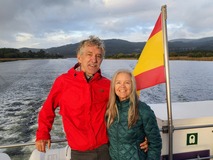
We’re not a travel agency ~ we’re fellow pilgrims! (See About Us)
We've trekked Pilgrimage Routes Across Europe since 2014!
💬 We’ve:
- Gotten lost so you don’t have to. 😉
- Followed waymarks in the glowing sunlight, the pouring rain and by moonlight. ☀️🌧️🌙
- Slept in albergues, hostels & casa rurals. Ate and drank in cafés along the way. 🛌 😴
- Created comprehensive and downloadable GPS maps and eBook Guides, full of must-have information based on real pilgrimage travels. 🧭 🗺️
- Shared our complete journeys, step by step to help YOU plan your ultimate pilgrimage and walk with your own Heart and Soul. 💙✨
Every detail is from our own experiences. Just fellow pilgrims sharing the Way. We have added a touch of spirituality, heartfelt insights and practical guidance from the road ~ offering a genuine connection to the spirit of pilgrimage. Tap into the wisdom of seasoned pilgrims!
Ultreia and Safe Pilgrimage Travels, Caminante! 💫 💚 🤍
Map and Stats of Day Two on the Camino Portugués
Here is my Google map that I created from my GPS files. I included restaurants, cafés, supermarkets and hotels on the map as well.
I added the route, in red that we took to rejoin the Camino, from the Alfa 10 hotel. If you include this route in your mileage for the day, you will need to add 1.5 km, for a total of 29.9 km for the day.
Here is the elevation profile for day two on the Camino Portugués. As you can see, it is almost totally flat! Essentially, a long, easy day.
👣 Camino Portugués eBook Guides
Enjoy all the valuable info from our web pages ~ offline, ad-free, and beautifully formatted, including our photos. Why carry a heavy guidebook when you can use a nimble digital version on your device?
Our guides are frequently updated and uniquely entertaining, as we share our own Camino story along the way.
📲 Instant download. 💸 Money-back guarantee. 🔄 Free updates for 1 year.
Buy only what you need ~ or grab all four for the price of three (25% savings). Click here for more information or BUY NOW at only 17.85!
Jump to Camino Portugués Stages
Photo-Rich Travelogue of Day Two on the Camino Portugués
After our grueling day one, I woke up on day two, feeling surprisingly well. Fortunately, I had slept well and was free of any aches, pains or blisters.
It was a fresh and dewy morning as we met our Swiss friend and set off at 7:00 a.m. We had 1.5 km from the Alfa 10, to get back to the Camino. We used our little printed map from our hosts to guide us, but you can use our GPS tracks if you downloaded them. Essentially it is a reverse of the way you came in, except at the 2nd roundabout, go straight onto the Avenida Queiroz for another 600 meters, and at the small roundabout join the Camino by turning left.
Luckily, there was a gas station along the 1.5 kilometer return route that was open! (Actually open 24 hours!) In Portugal, 7:00 a.m. is very early, and very few cafés are open before 8:00 or 9:00 o'clock.
We stopped for café con leite and pastry. Everyone was chipper, and ready for rockin' and rollin.'
When we joined the Camino on the Avenida Infante Dom Pedro, the way immediately turns to the right onto the R. Dom João, then veers to the left on the Rua 20 de Maio 1449. The Way then takes a turn to the right onto the Rua Catarina Eufémia, shown below.
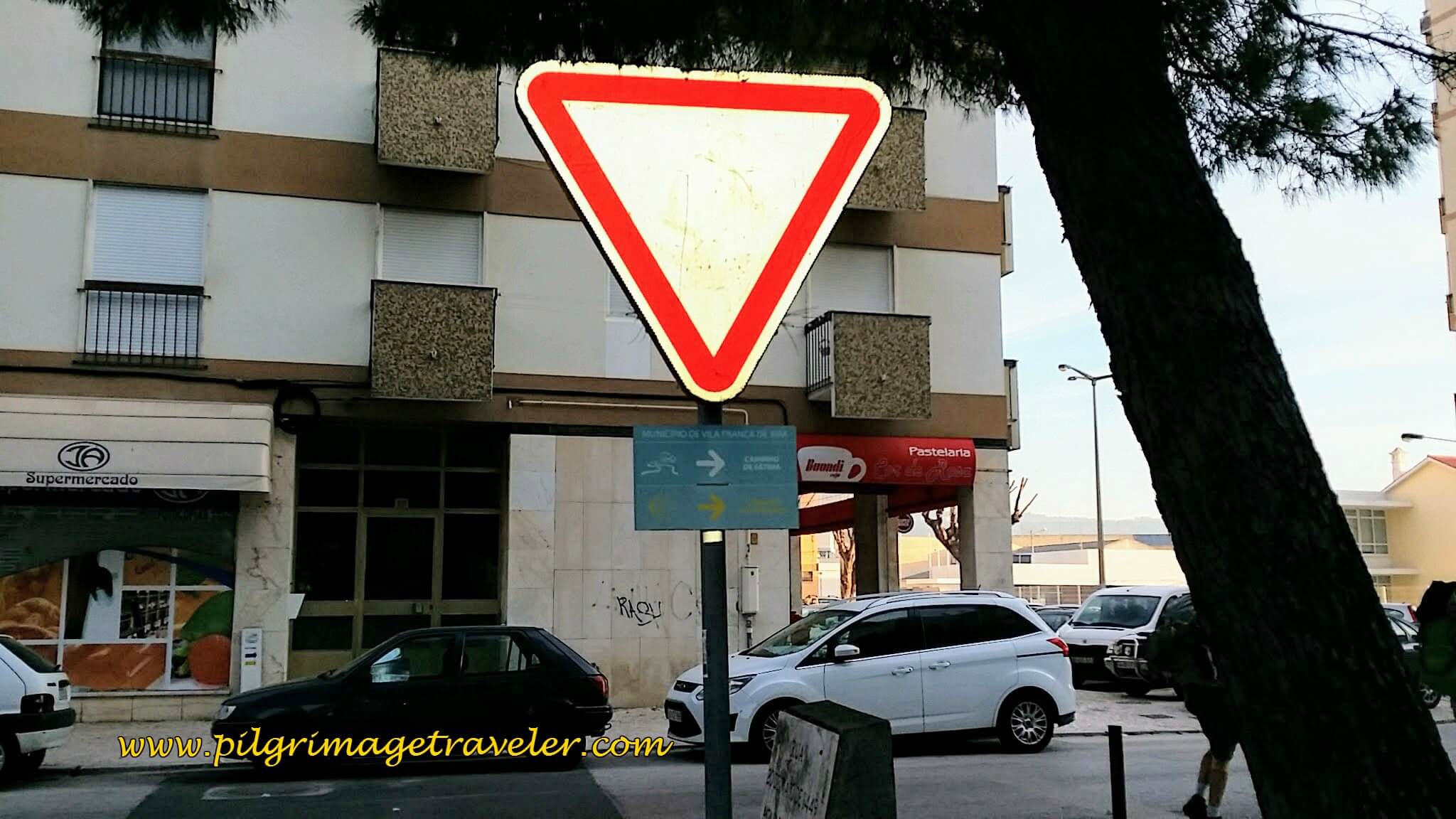 Right Turn on the Rua Catarin Eufémia
Right Turn on the Rua Catarin EufémiaAfter turning right onto the Rua Catarin Eufémia, up ahead it looks like the road ends into a dead end at a field. Instead, you will see a directional sign on a light pole, below, and you turn left onto a path by the building’s white fence, shown in the next photo. The crop or invasive weed here is the common cane, or reed. It was quite overgrown the times we passed through.
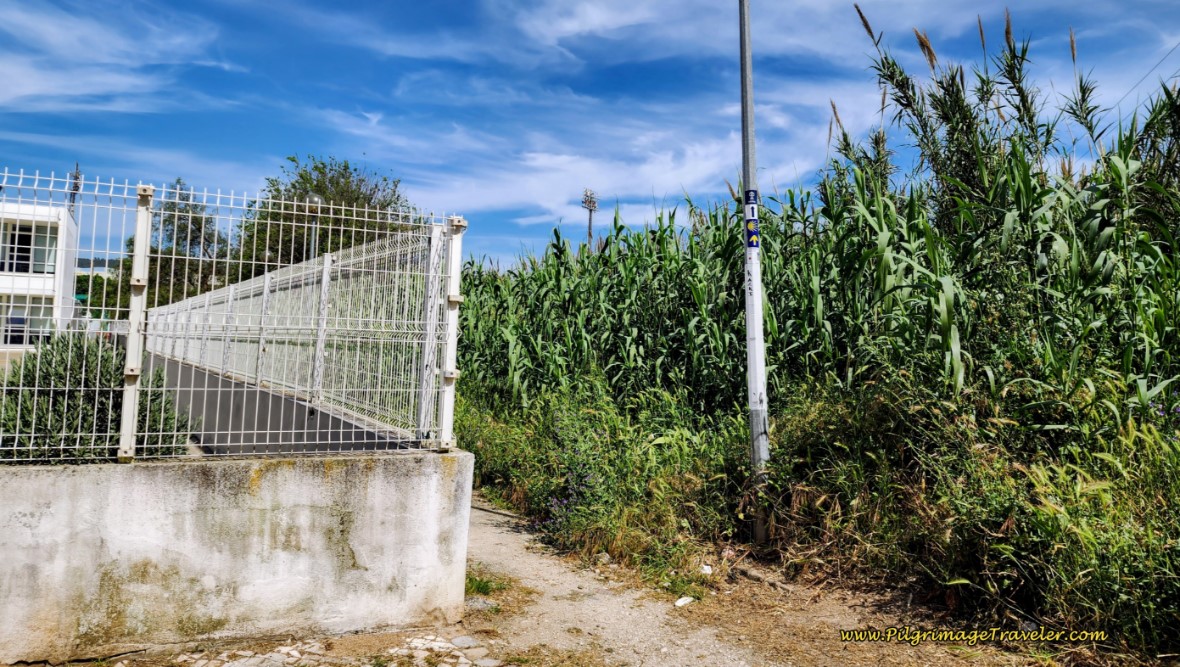 Turn Left Here at Cane Field Dead End
Turn Left Here at Cane Field Dead End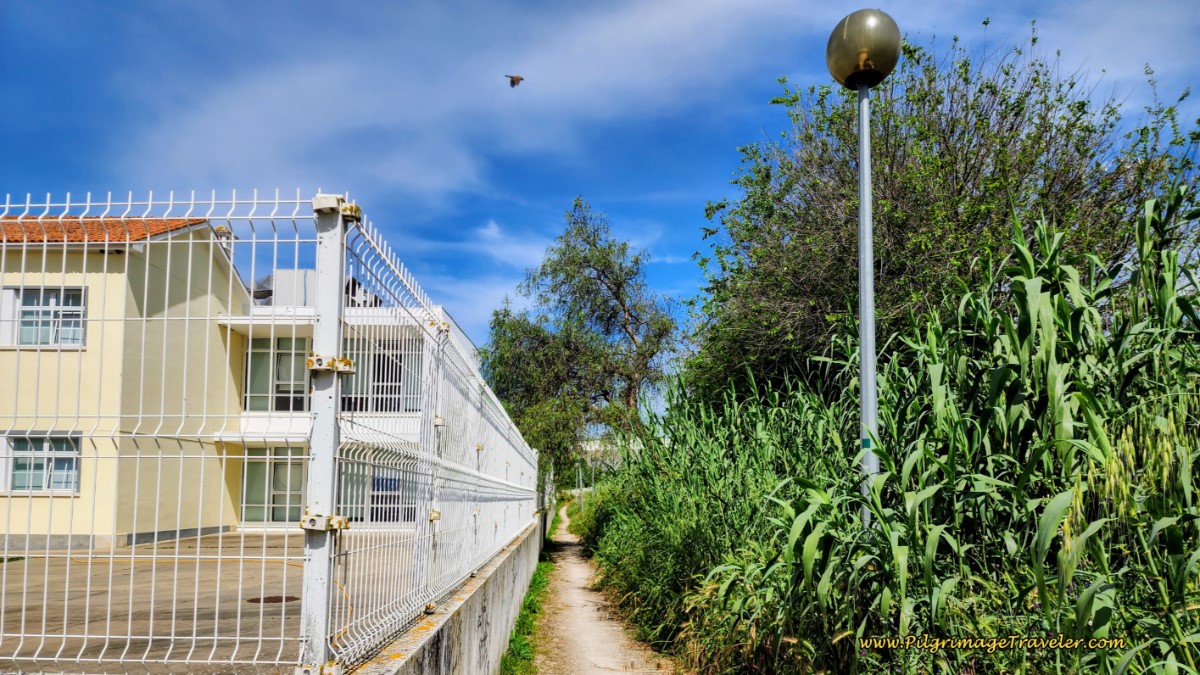 Path along the White Fence
Path along the White FenceThe path soon leaves the building, by turning to the right, crosses a ditch, meanders around a bit before crossing a long field as it leaves Alverca.
The path approaches the buildings on the other side, comes to a T-intersection with a gravel road and turns to the right. The gravel road winds around some industrial buildings, turning to the left a few meters later onto the pavement of the Rua Quinta do Pinheiro.
Next, you will walk through some warehouse areas with heavy truck traffic for the next full kilometer before joining the busy N10 in the town of Sobralinho at a large roundabout, approximately 2.2 kilometers into the day.
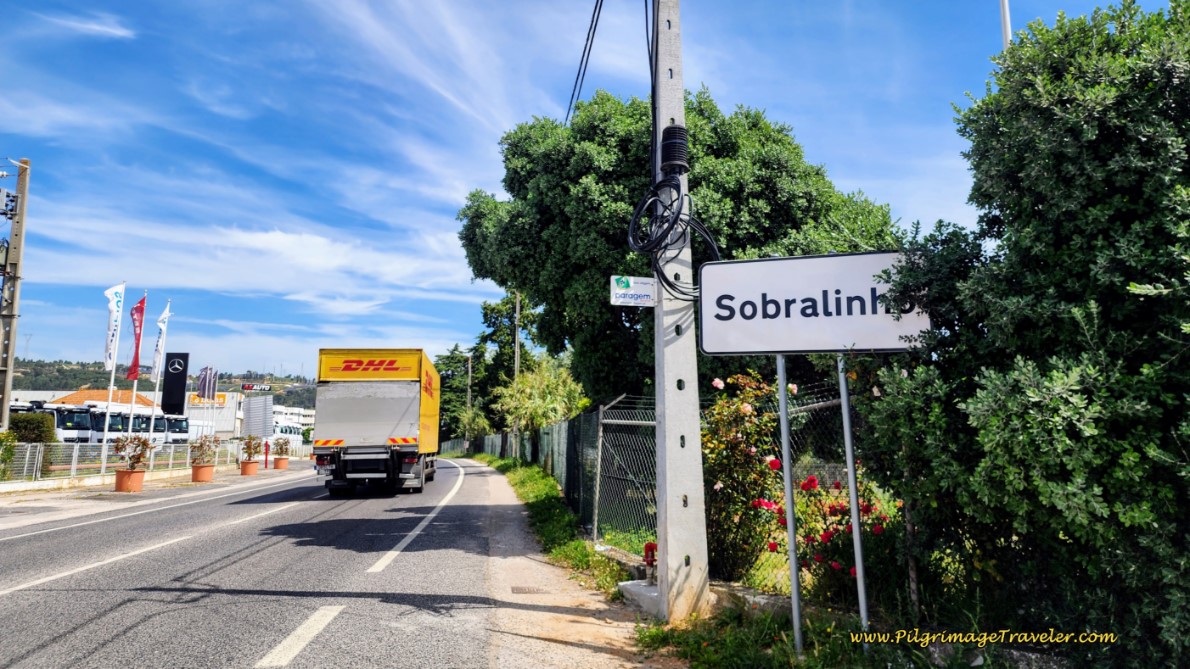 The Portuguese Way Joins the Busy N10 in Sobralinho
The Portuguese Way Joins the Busy N10 in SobralinhoThe Camino can be quite dangerous here especially if the traffic is heavy as it follows the N10 for more than two kilometers, walking through Sobralinho on the way to Alhandra. As the road bends and the shoulders changed, to be as safe as possible on this road, we found ourselves choosing to cross from right to left to find the safest passage. There are several cafés through here if you need a stop.
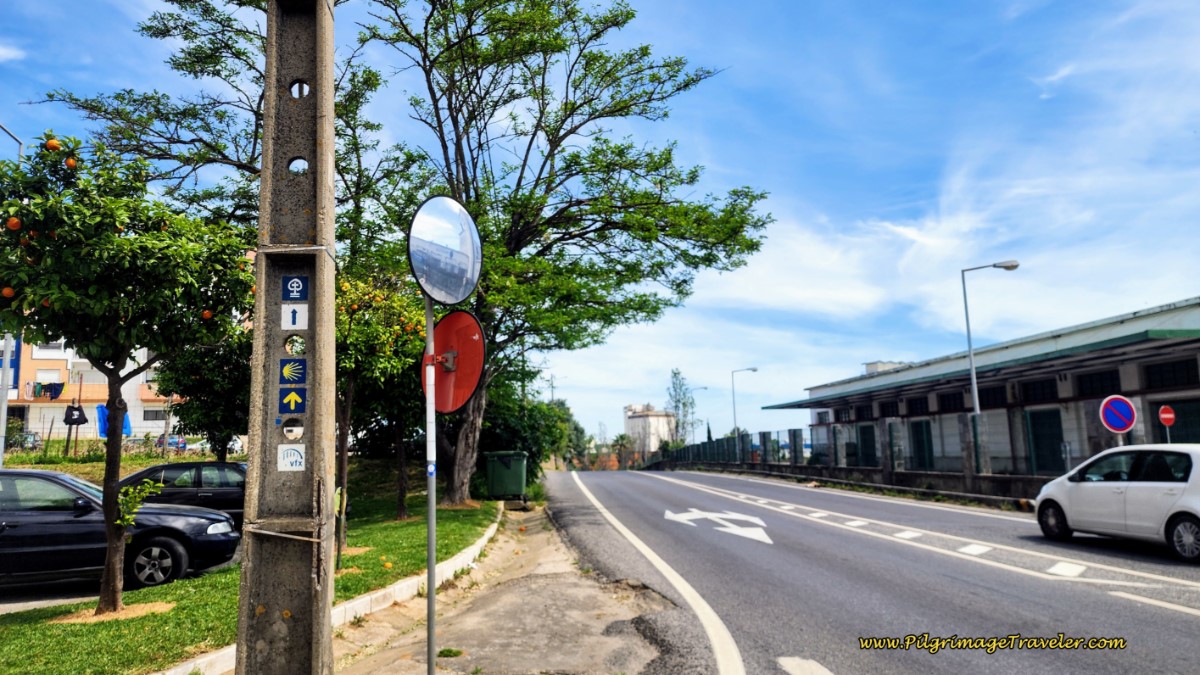 Waymarks Along the N10
Waymarks Along the N10When you see the sign for Alhandra, and you walk under the coal shuttle, pictured below, after not quite 4.0 kilometers into day two on the Camino Portugués, you know this stretch on the N10 is almost over.
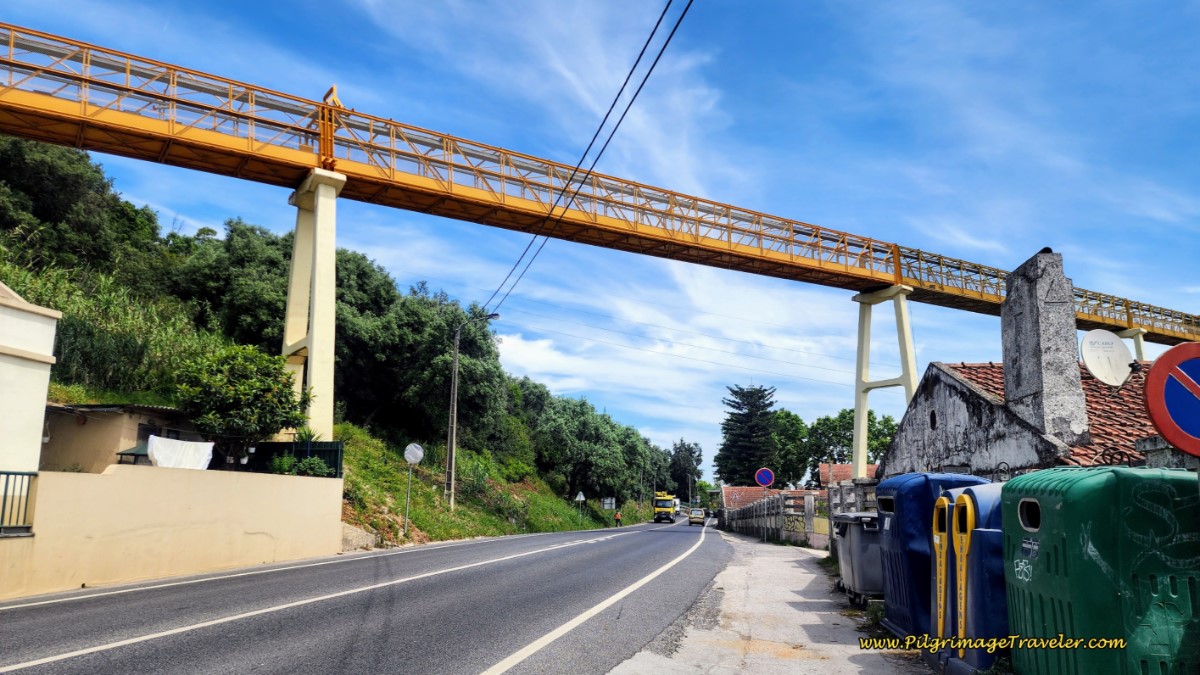 Walking into Alhandra Under Coal Shuttle
Walking into Alhandra Under Coal ShuttleAfter entering Alhandra, you can see the train station to your right as the N10 climbs left, at the Y-intersection, shown below, to the overpass.
Once upon a time there was a clear waymark post at this intersection, but now it is gone. The way to go is left, to stay on the N10.
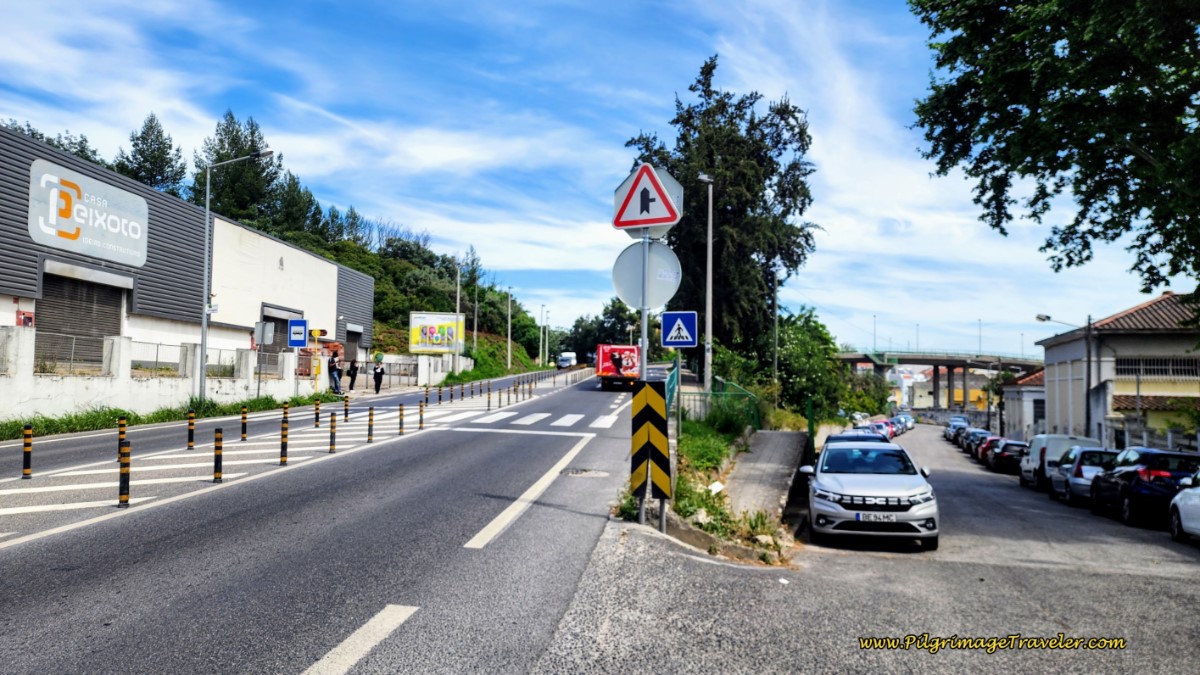 Stay Left on the N10 by the Alhandra Train Station
Stay Left on the N10 by the Alhandra Train StationA few meters beyond the intersection, a pedestrian way appears, and you will take this up and over the bridge to your right. The waymark sticker validates that you are taking the correct way.
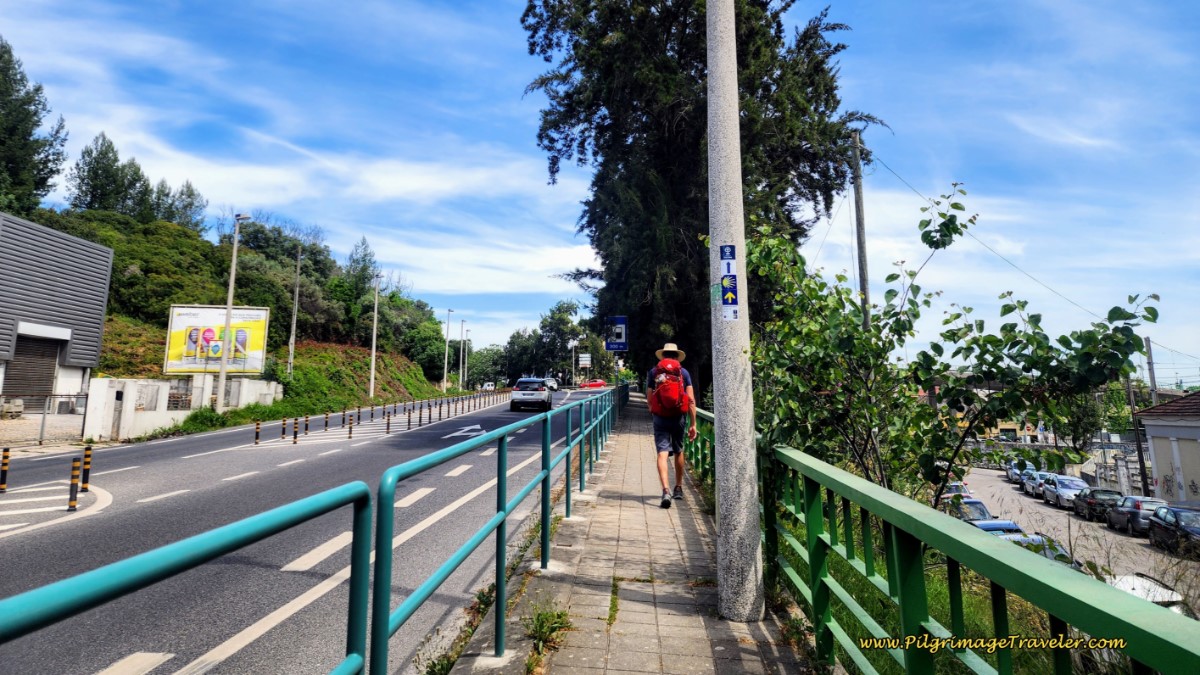 Pedestrian Way Over Bridge
Pedestrian Way Over BridgeWalking over along the overpass you will get a bird's eye view of the train station and the industry around it.
Onwards we went, up and over the bridge and back towards the waterfront. As you walk through the town of Alhandra, there are many cafés where you can stop for a bite if you need.
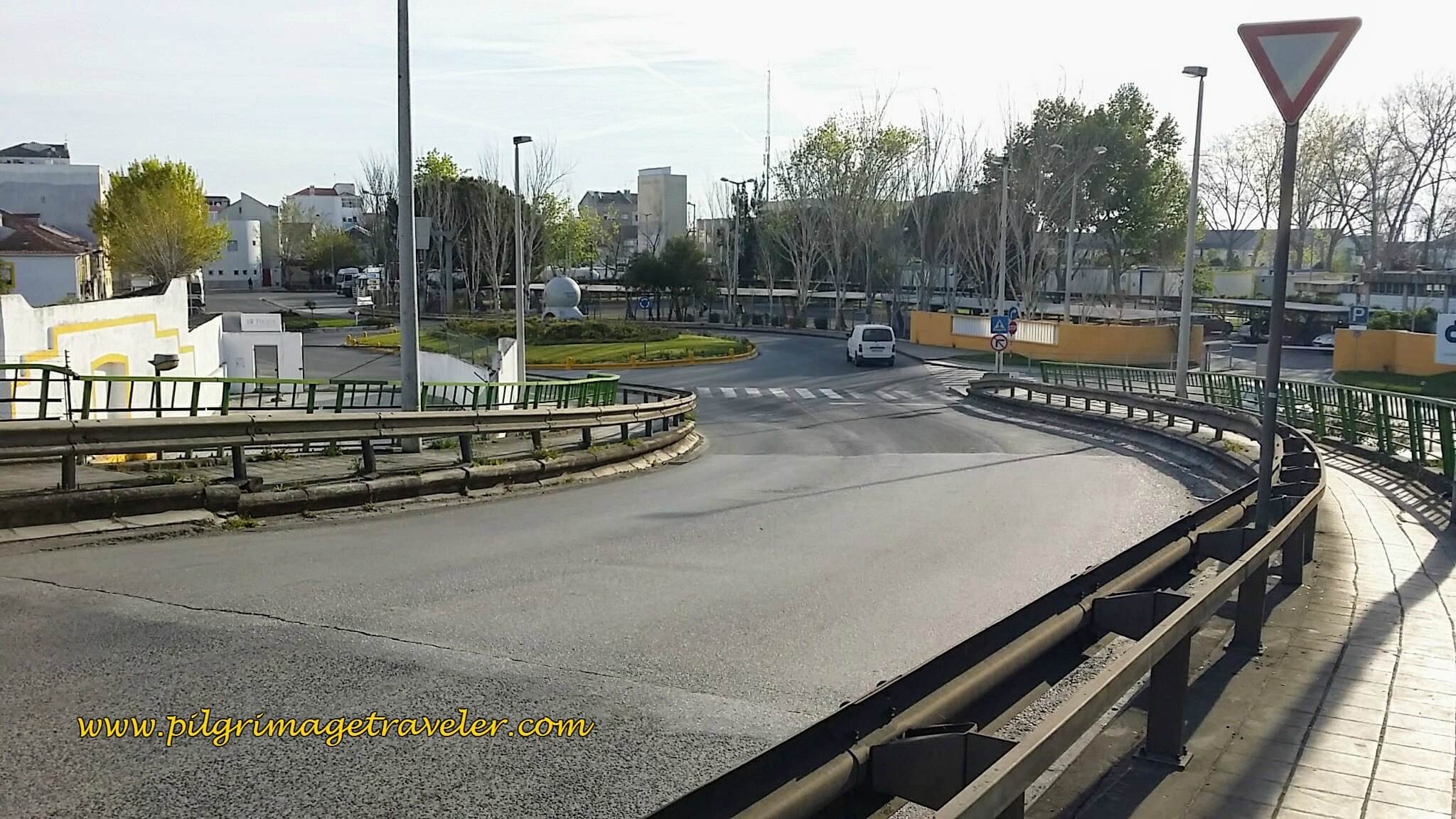 Over the Train Tracks by the Alhandra Train Station
Over the Train Tracks by the Alhandra Train StationJump to Camino Portugués Stages
After the overpass, the street bends to the left and you walk through a large roundabout, taking the second right to head towards the sea. Less than 200 meters later, a left turn takes you to the waterfront. You are at about five kilometers total when you reach the waterfront.
Here is where the Way joins the Passeio Pedronal Ribeirinho de Alhandra, or essentially translated, the Alhandra Riverwalk.
The Portuguese are very friendly, when you engage them. As several bicyclists passed us on the riverwalk, one called out to us, "Good Morning!" I returned the salutation with "Bom dia," and I got a hearty a thumbs up in return!
The Riverwalk continues for about one kilometer as it passes through town. There are nice areas to rest and have a break here if you need it!
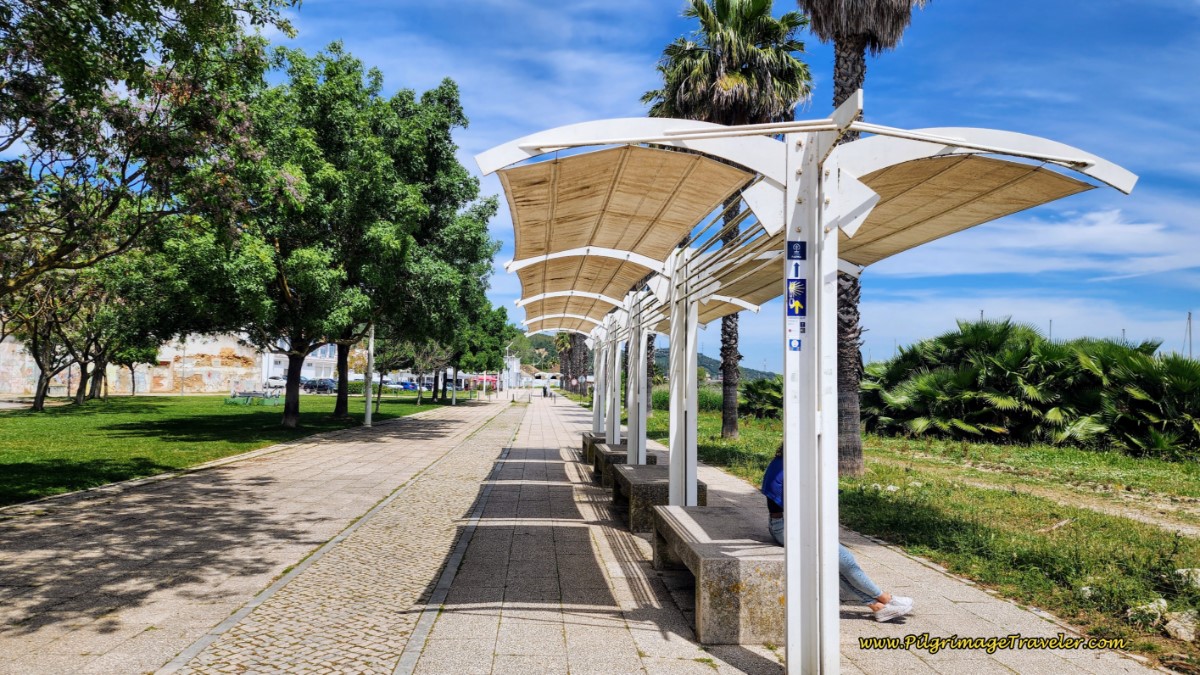 Shady Benches Along the Alhandra Riverwalk
Shady Benches Along the Alhandra RiverwalkAfter leaving the town of Alhandra, the Passeio Pedronal Ribeirinho becomes the Caminho Pedronal Ribeirinho. It follows this 2-way track along the Rio Tejo for the next 2.6 kilometers, or so.
This walking/jogging track, has many local Portuguese out and about. It is easy to see why, as we walked on this beautifully planned walkway.
Next you will pass a Portuguese Bull ring after about 8.25 kilometers into the day.
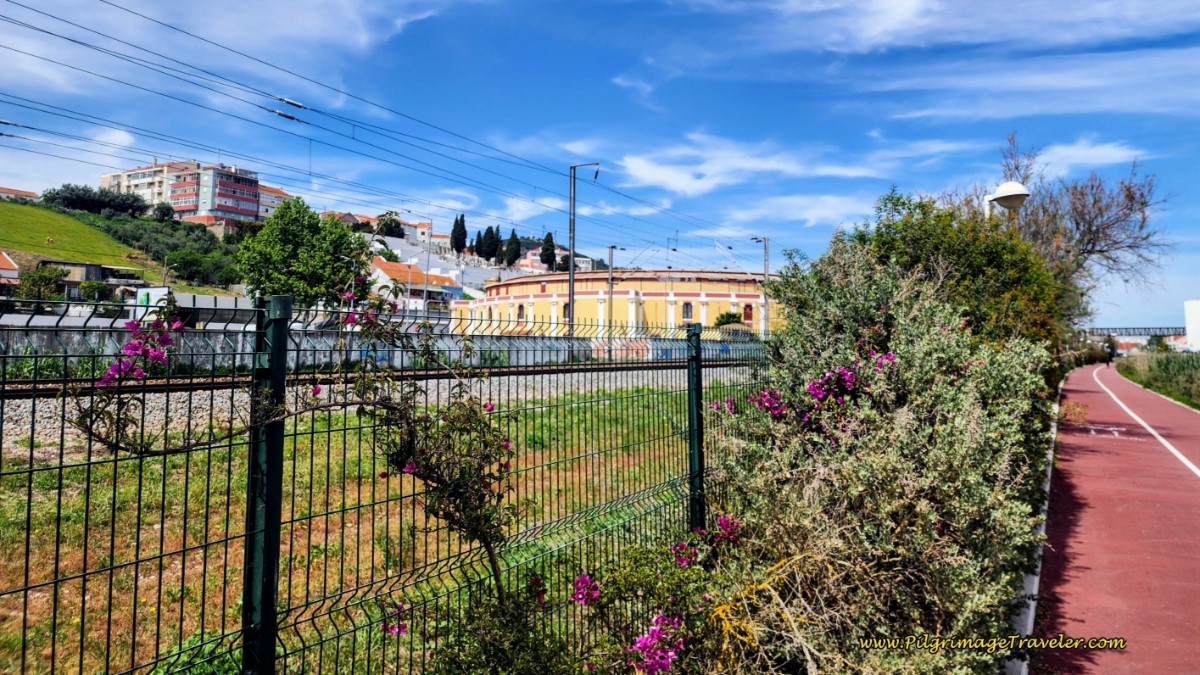 Pass Portuguese Bull-Fighting Ring
Pass Portuguese Bull-Fighting RingBelow is the final stretch on the Caminho Pedronal Ribeirinho, lined with gorgeous blooms and with a pedestrian overpass ahead by the white building.
And pictured next is the Way as it walks into Vila Franco de Xira itself.
The 2-way track ends at the sculpture of Álvaro Guerra, a famous author and journalist from Vila Franca de Xira, after about 8.6 kilometers into the day.
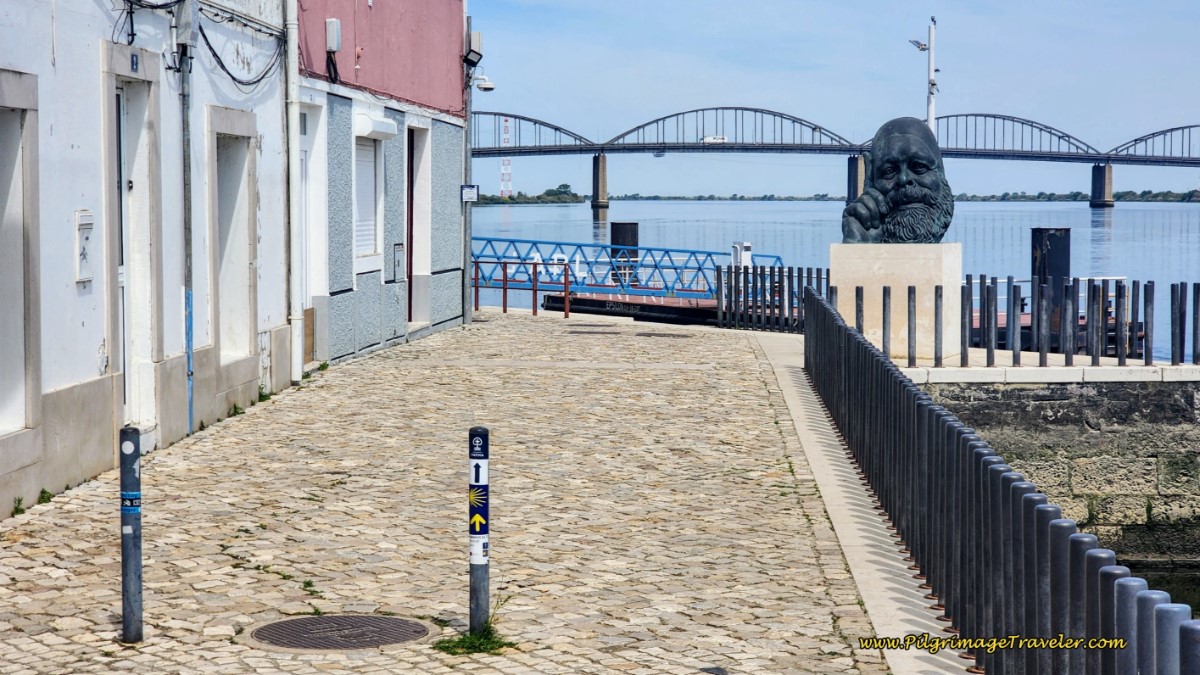 Tribute Sculpture of Álvaro Guerra
Tribute Sculpture of Álvaro GuerraThe Camino de Santiago continues past the sculpture and along the waterfront. It was here that we decided to go into town to look for a café for a coffee break. At this lovely tile building by the marina, we turned left into town.
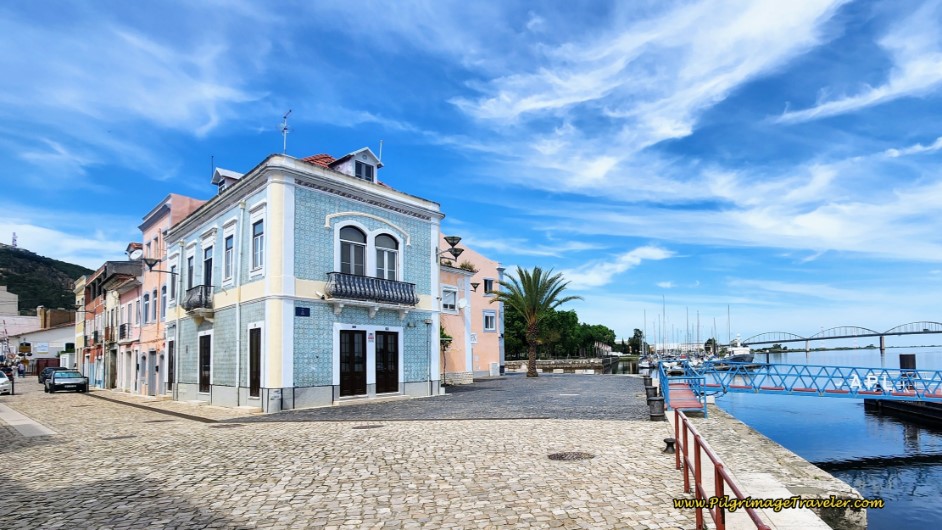 Along the Waterfront in Vila Franca de Xira
Along the Waterfront in Vila Franca de XiraThe town is lovely, and we soon found a very inviting pastry shop. Here are the boys, selecting a table. We were soon scarfing down empanadas and more pastel de nata!
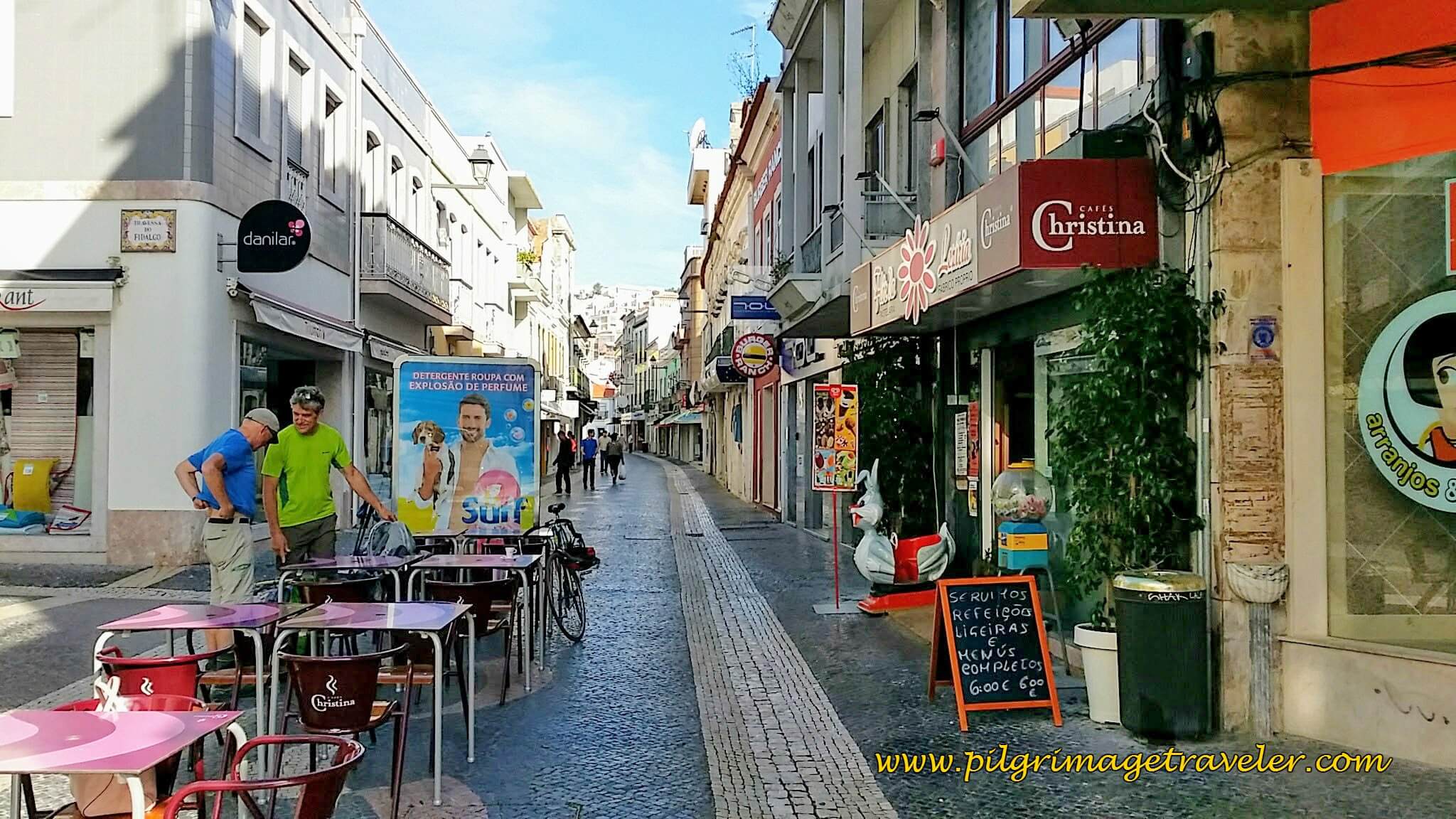 Pastelaria ~ Yum Yum!
Pastelaria ~ Yum Yum!While taking our break, our Swiss friend, desiring to lighten his load, started tearing pages out of his guide book that he no longer needed! He confessed that he had two books, and he already ditched one back at the hotel in Verdelha.
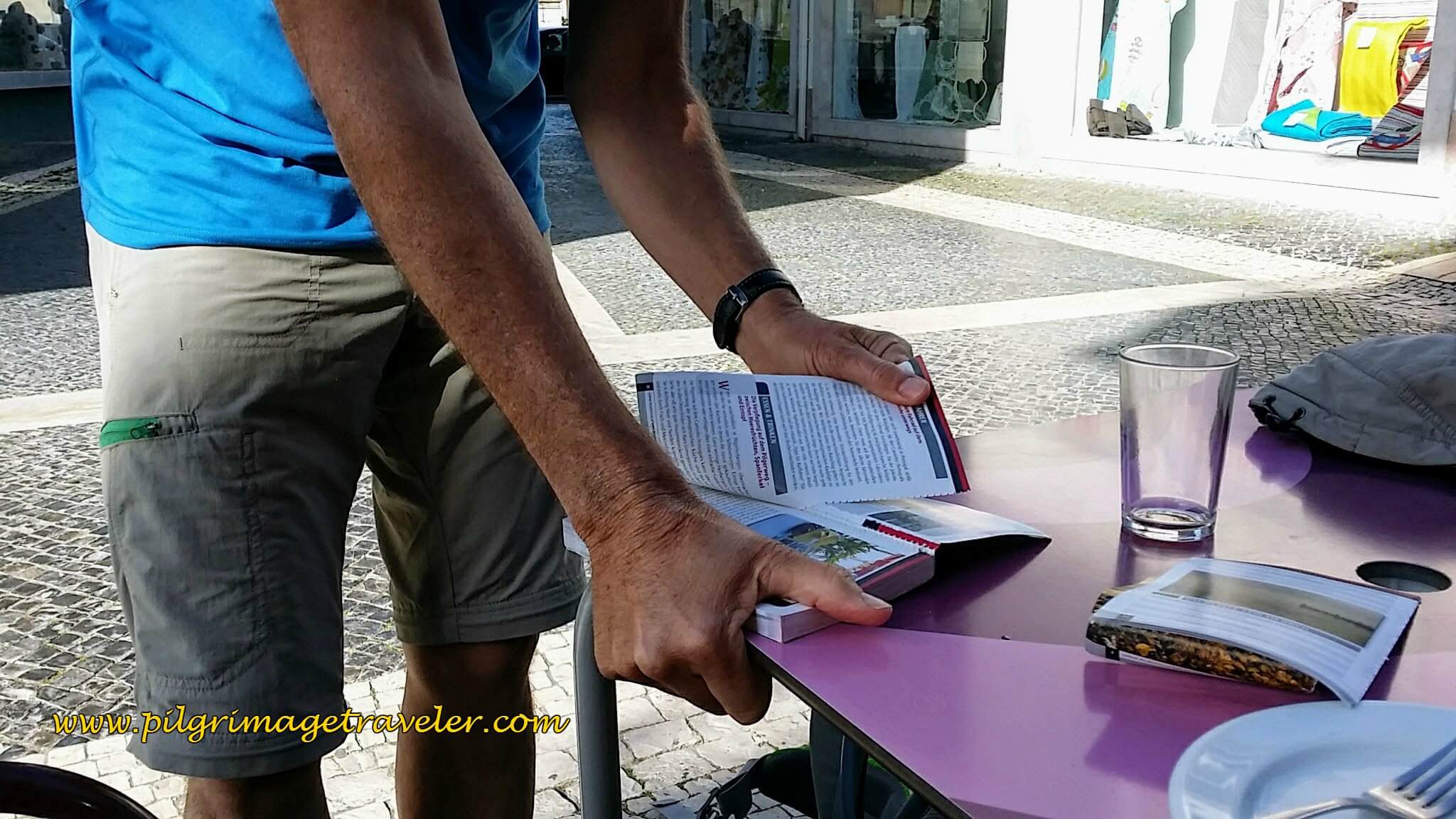 Our Swiss Friend Lightening His Load
Our Swiss Friend Lightening His LoadSince it was already hot by the time we stopped for our break at 9:00 a.m. it was imperative that he lighten his pack. If the afternoon would be anything like day one, it was going to be a very hot one.
Rich picked up our friend's pack, and then I did. OMG, it was about twice as heavy as Rich's. When we commented on how heavy the pack was, our Swiss friend only replied that this was a "normal" weight. Obviously this was his first Camino!
We chuckled and stated, that yes, his weight might be normal for a backpack in the Swiss Alps for a few days, but way too heavy for a pilgrimage traveler! He didn't say a word in return. Each to his own!
The town of Vila Franca de Xira is quite charming. Fortunately, at a later time, we were able to explore it more!
Below, in the Praça Afonso de Albuquerque, next to the headquarters building of the Vila Franca de Xira City Council is the 16th C. Manueline Pillory. It is one of the few historic monuments in Vila Franca de Xira and even parts of it were updated several times. This square is a great place to hang out and take in the vibe!
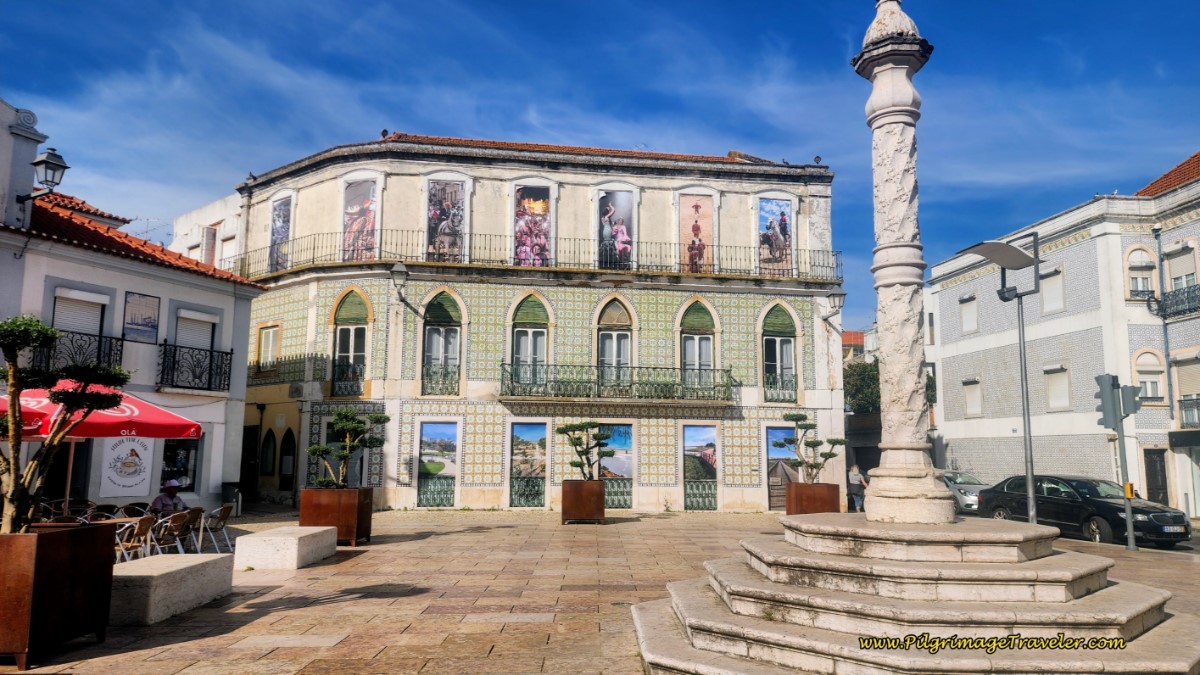 Pelourinho de Vila Franca de Xira
Pelourinho de Vila Franca de XiraAnd pictured next is the azulejo-tiled Municipal Market, a typical and authentic Portuguese building.
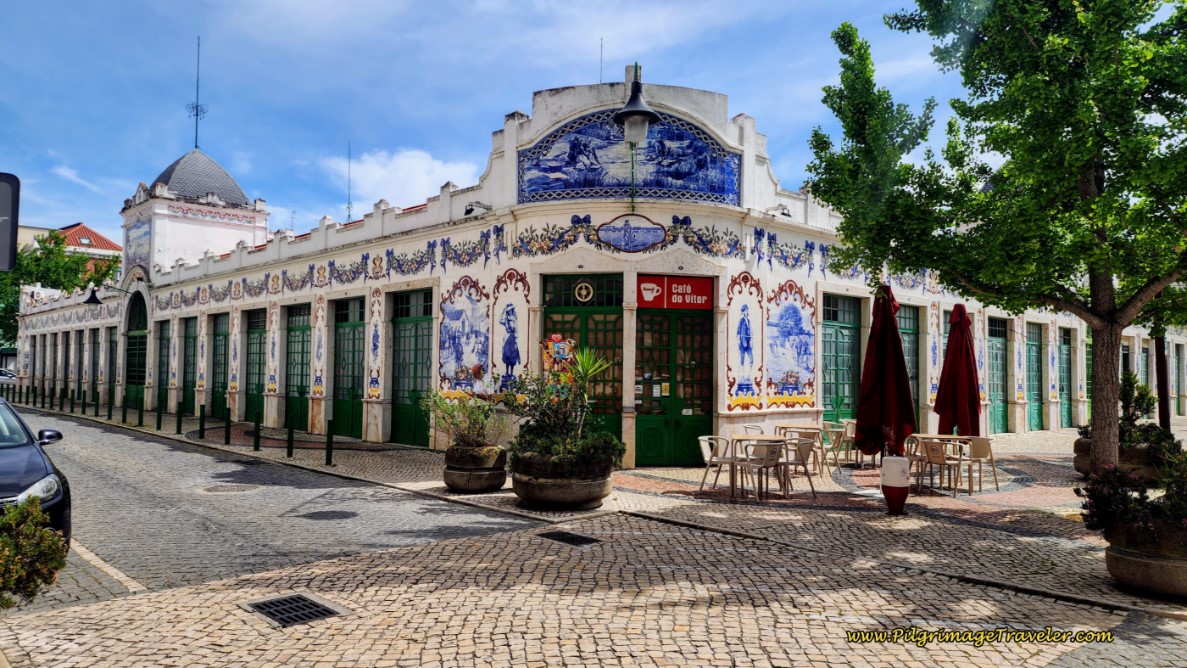 Mercado Municipal de Vila Franca de Xira
Mercado Municipal de Vila Franca de XiraIndeed, if you decide to spend the night here, there is the Suites and Apartments DP VFXira, a few blocks from the waterfront and right across the street from the municipal market. We have stayed here and the rooms are small and cramped but adequate. However, the staff was amazingly friendly and helpful and breakfast was phenomenal!
There is also the Pensão Ribatejana, (+351 926 070 650) along the Way, the Hospedaria Maioral (+351 263 274 370) in the center and finally, farther north out of town, the Lezíria Parque Hotel.
Jump to Camino Portugués Stages
After our Swiss friend lightened his pack by a few pages, and we all added much more weight into our stomachs, we rejoined the Camino at the waterfront. Very shortly, we entered this park, the Park Jardim Municipal Constantino Palha. Another place for a wonderful break, if you were carrying a picnic.
This park is such an amazing and lovely retreat from the hot Portuguese sun. I continued to be amazed on only day two of the Camino Portugués, how hot and dry it already was in Portugal in early April. At least the year we first walked!
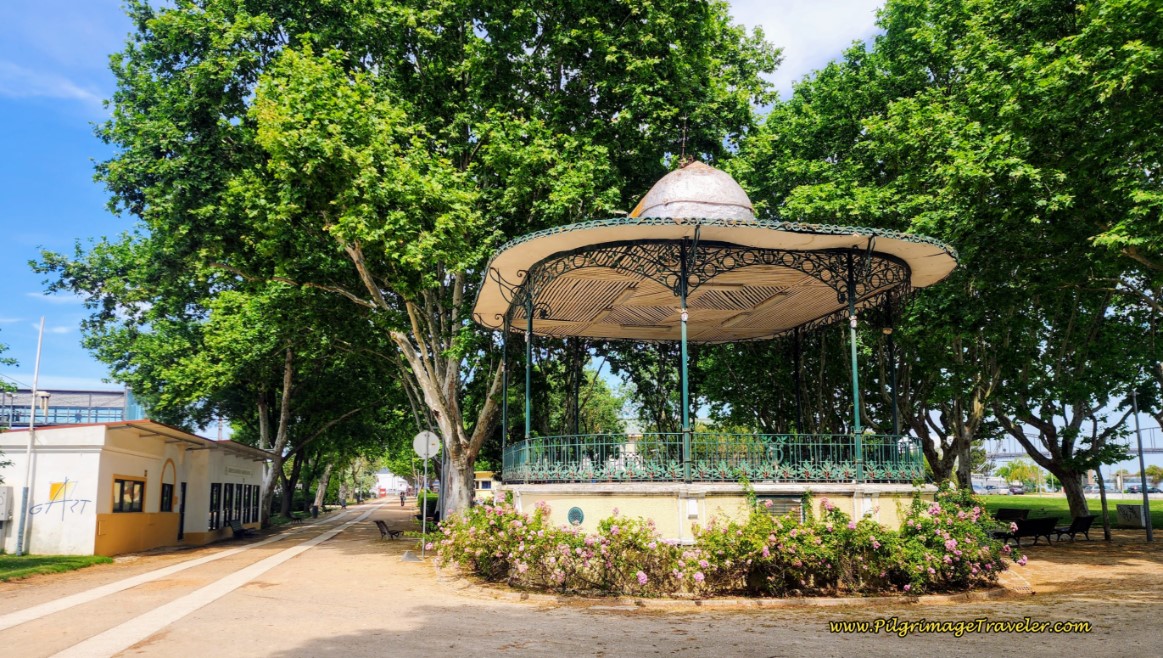 A Grand Stand at the the Park Jardim Municipal Constantino Palha
A Grand Stand at the the Park Jardim Municipal Constantino PalhaIn the middle of the park, the Vila Franca Train Station is on your left. It is a gorgeous building and I took several pictures of it.
After leaving the cool, shady park of Vila Franca, the real Camino began for me.
The road after the park is narrow and busy, but paved as it walks out of town. Here the surrounding fields are wide open, totally devoid of shade, or any attractive features. This is another stretch of roadway where you need to exercise caution for the one-and-a-half kilometer stretch or so. The unnamed road crosses under the N10 and eventually leaves the pavement to turn right at this junction
The unnamed road crosses under the N10 and eventually leaves the pavement to turn right at this junction after approximately 10.5 total kilometers into the day.
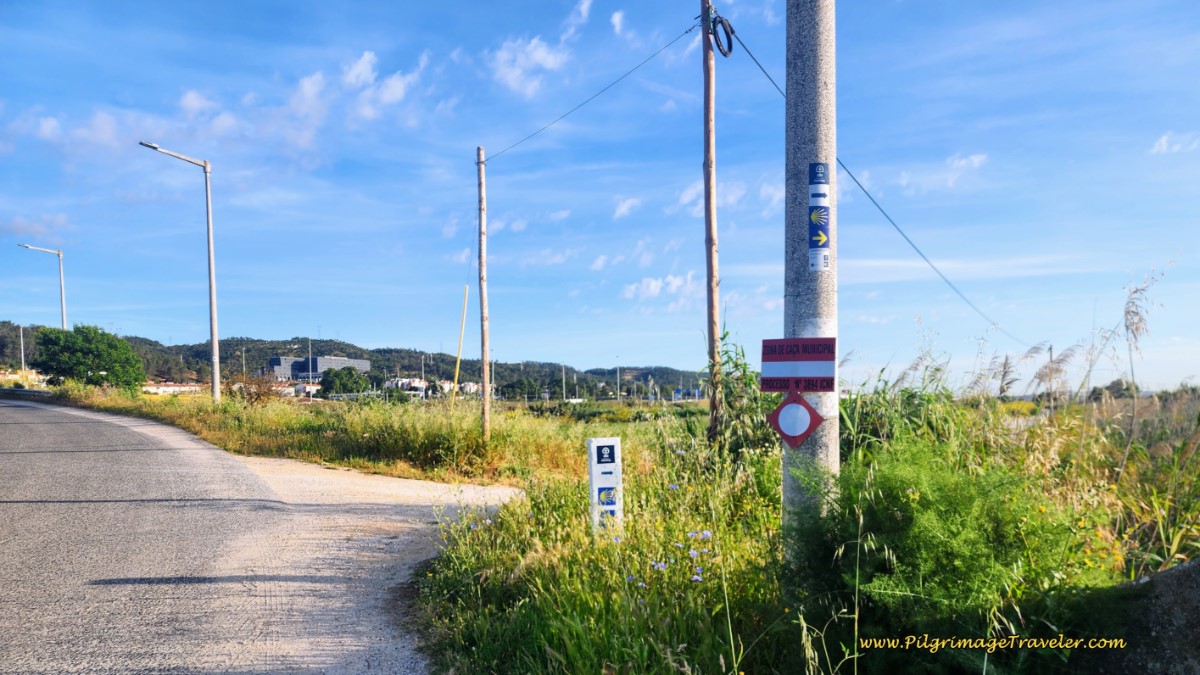 Leaving the Pavement to Turn Right Unto Dirt Lane
Leaving the Pavement to Turn Right Unto Dirt LaneThe dirt lane takes you in the direction of the next town, Castanheira do Ribatejo.
The road follows the railroad tracks as seen in the next photos below.
At first, the Way through this section is via open fields as pictured above, then walks through some industry, seen below, then winds around more industry buildings before traveling back into open fields, pictured next.
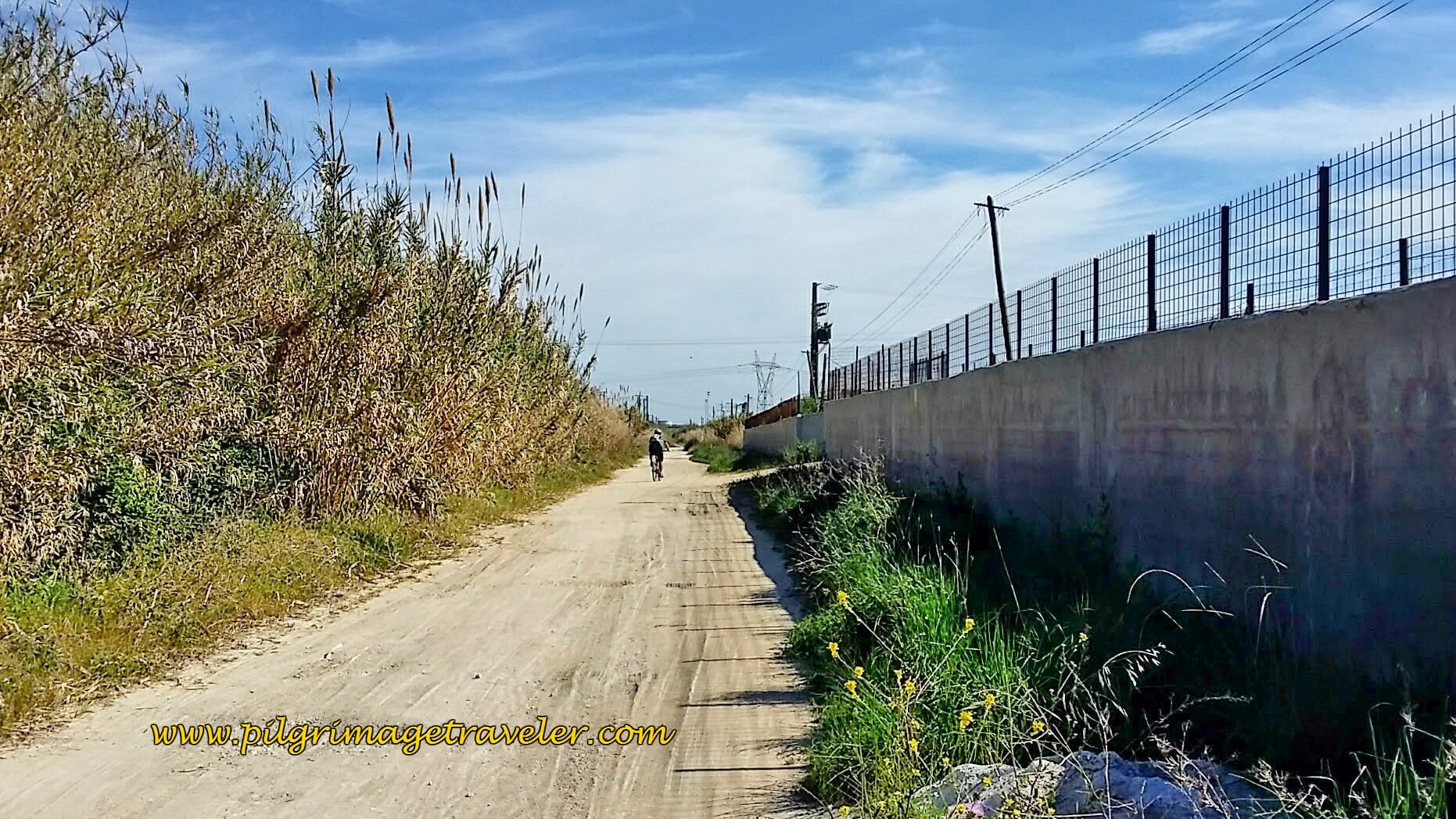 Lane Joins the Railroad Tracks
Lane Joins the Railroad Tracks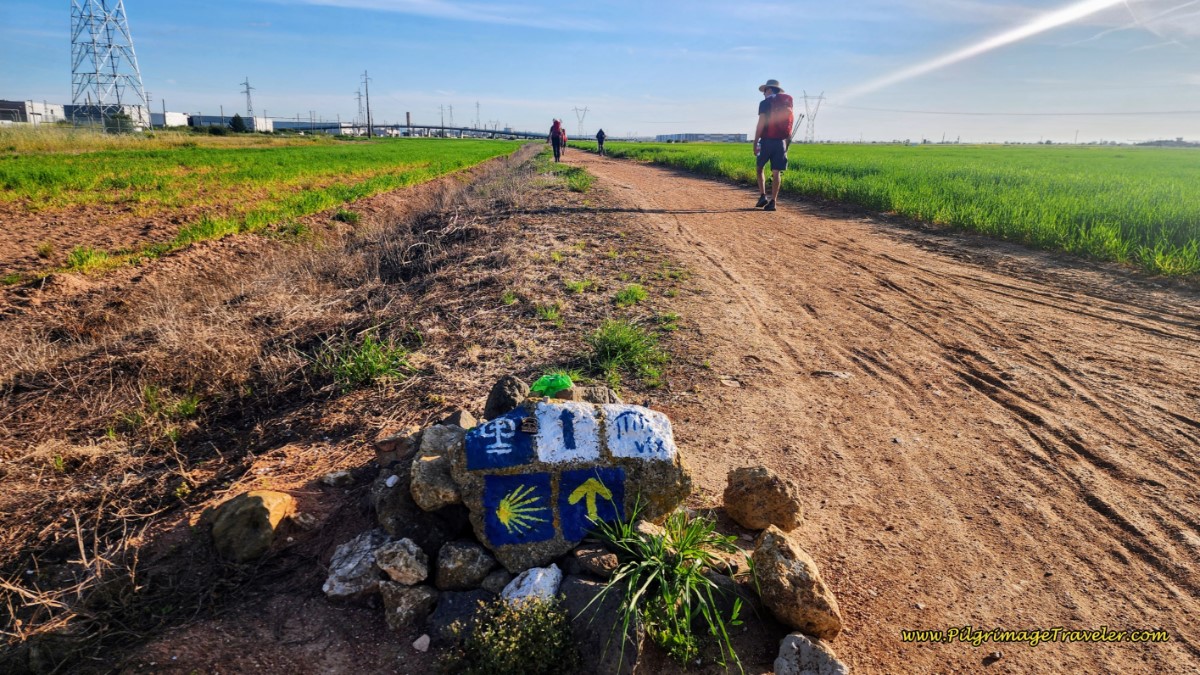 Hot, Open Lanes, Well-Waymarked
Hot, Open Lanes, Well-WaymarkedIt took me a while to figure out the waymarks. The dual Caminos waymarks were easy, two for Fátima, two for the Camino de Santiago, and on the far right is a depiction of a bridge, the famous one across the Tejo in Vila Franca de Xira! The VFX stands for the Vila Franca de Xira municipality who created the waymarks. Lightbulb moment!
While the photos don't depict it well, the large power plant in Carregado (see below) is within sight, almost the entire way from Vila Franca to Carregado on day two on the Camino Portugués.
The winding dirt track does not join the pavement until it reaches the Estrada do Apeadeiro, just before the train station in Catanheira do Ribatejo, shown below. The glass building over the street ahead, is the train station.
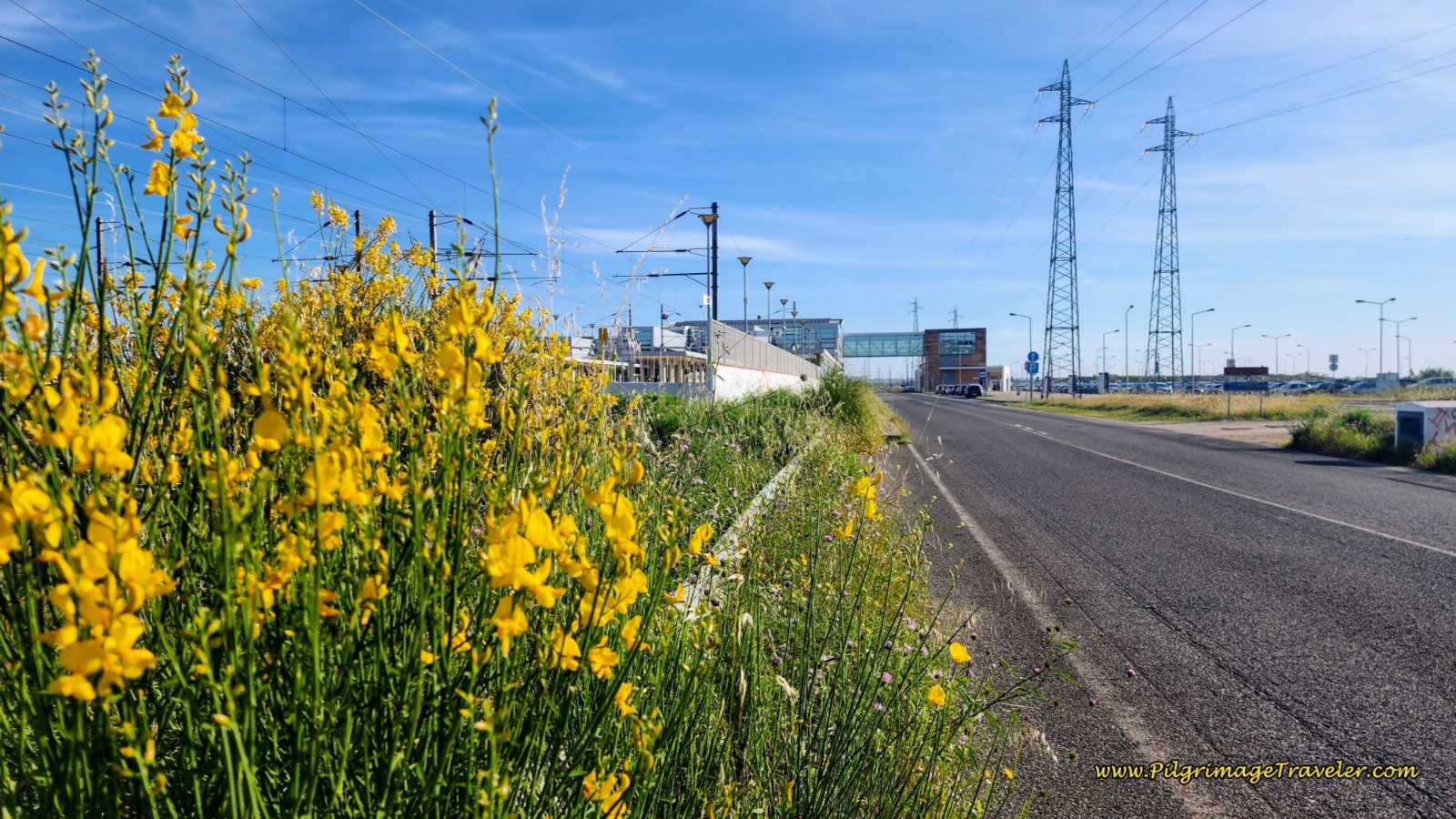 Walking Towards Castanheira do Ribatejo Train Station on the Estrada do Apeadeiro
Walking Towards Castanheira do Ribatejo Train Station on the Estrada do ApeadeiroI promised I would show the good, the bad and the ugly on the Portuguese Way and my photos of this section on day two of the Camino Portugués fulfills my promise!
I couldn't decide which part of the Camino from Vila Franca de Xira was least desirable, the long, hot dirt lane, or the long, hot paved roads!
You arrive at the station after 13.5 kilometers into your day.
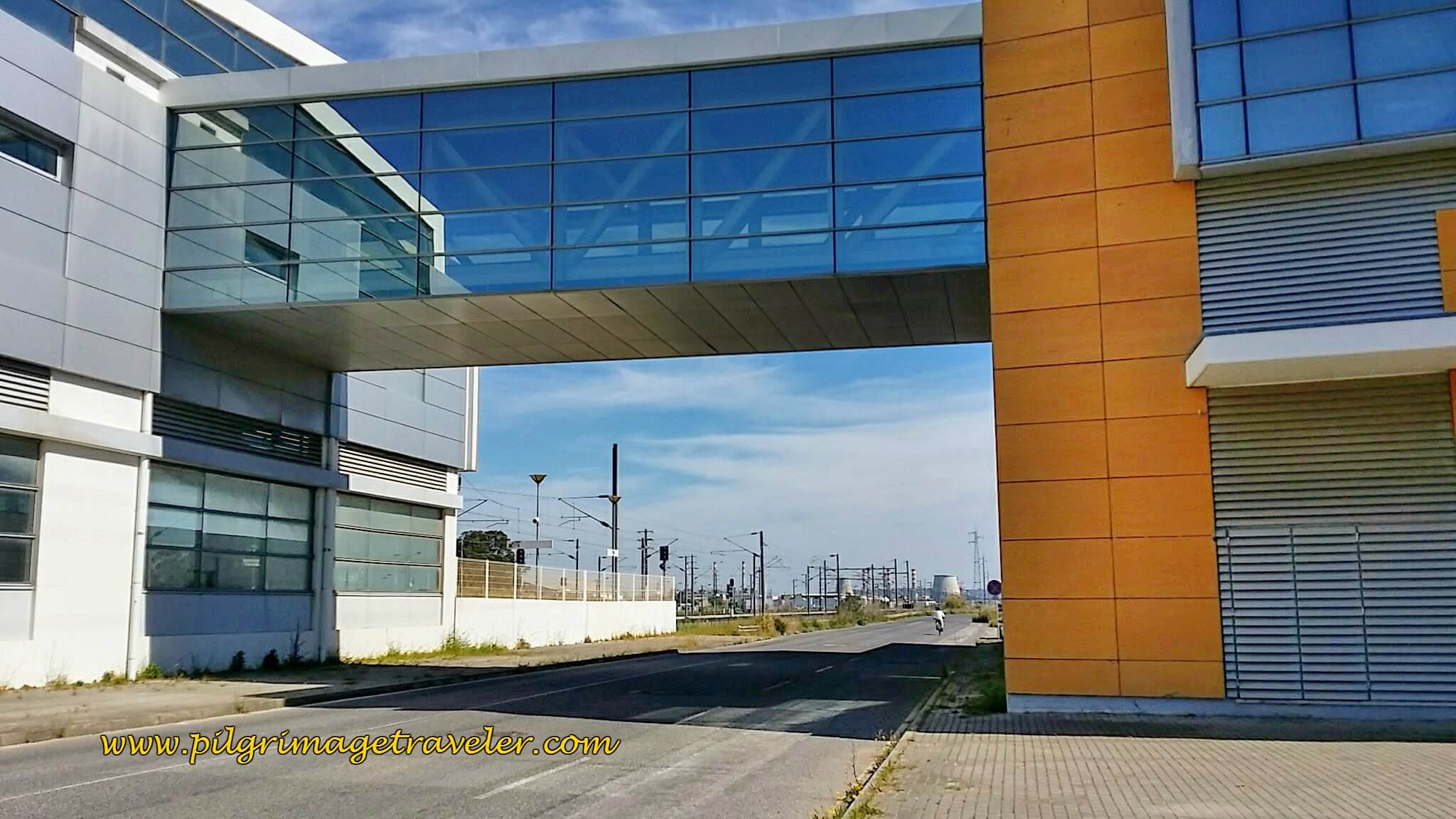 Castanheira do Ribatejo Train Station
Castanheira do Ribatejo Train StationThe long, hot pavement continues onwards toward Carregado, for the next 2.25 kilometers of open pavement. This section, was clearly, just putting one foot in front of the other.
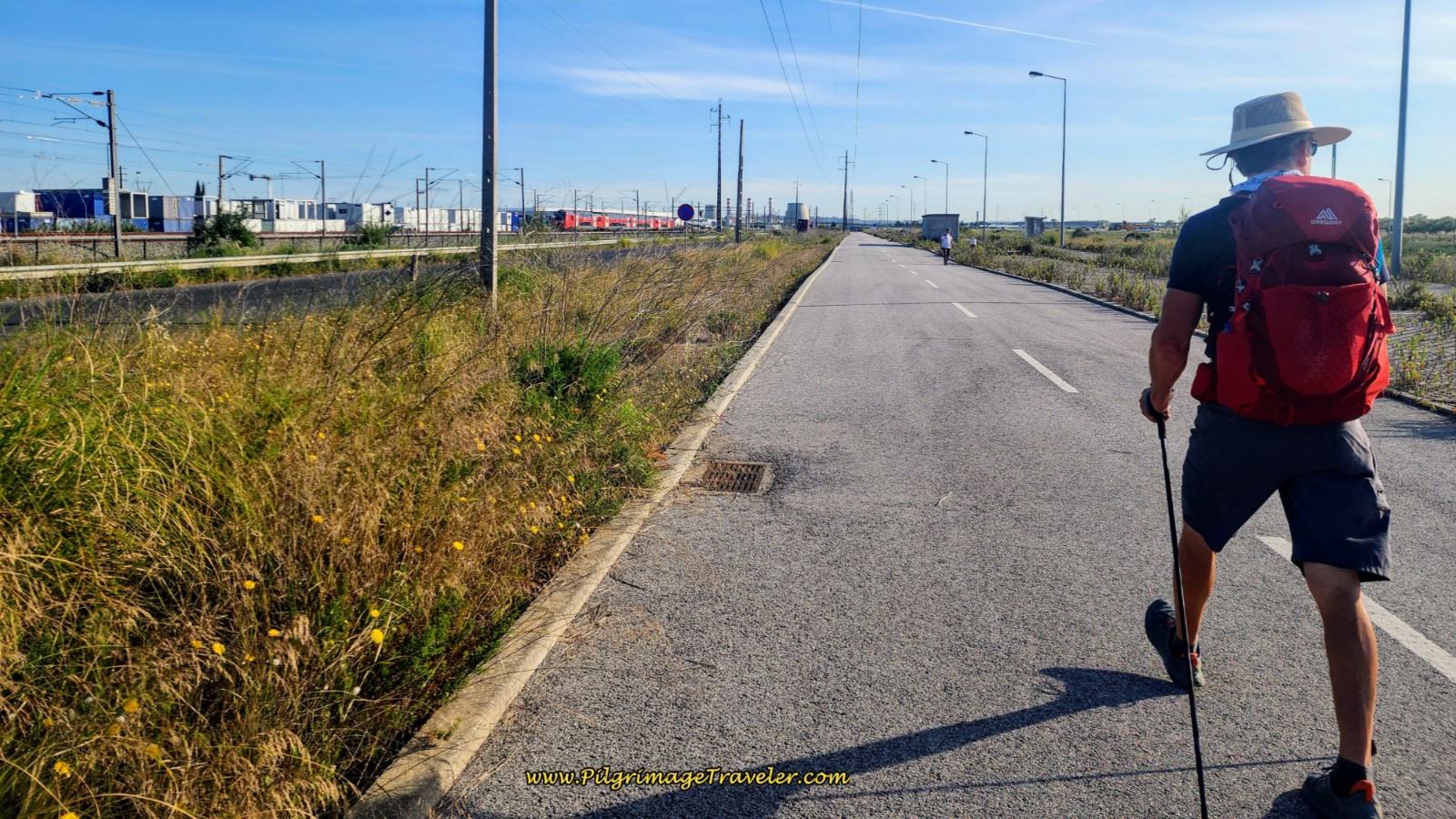 Paved, Barren Road Toward Carregado
Paved, Barren Road Toward CarregadoEven though you can't see it in the photo above, there is a shoulder once in a while to get off the hard surface of the pavement. It did help to walk on the shoulder.
Along this section, you will come to a roundabout, where you continue straight owards. As the road comes to a T-intersection, the Camino turns left onto the Rua Prudêncio Duarte Correira, and after 1/2 kilometer, you will arrive at the Carregado train station.
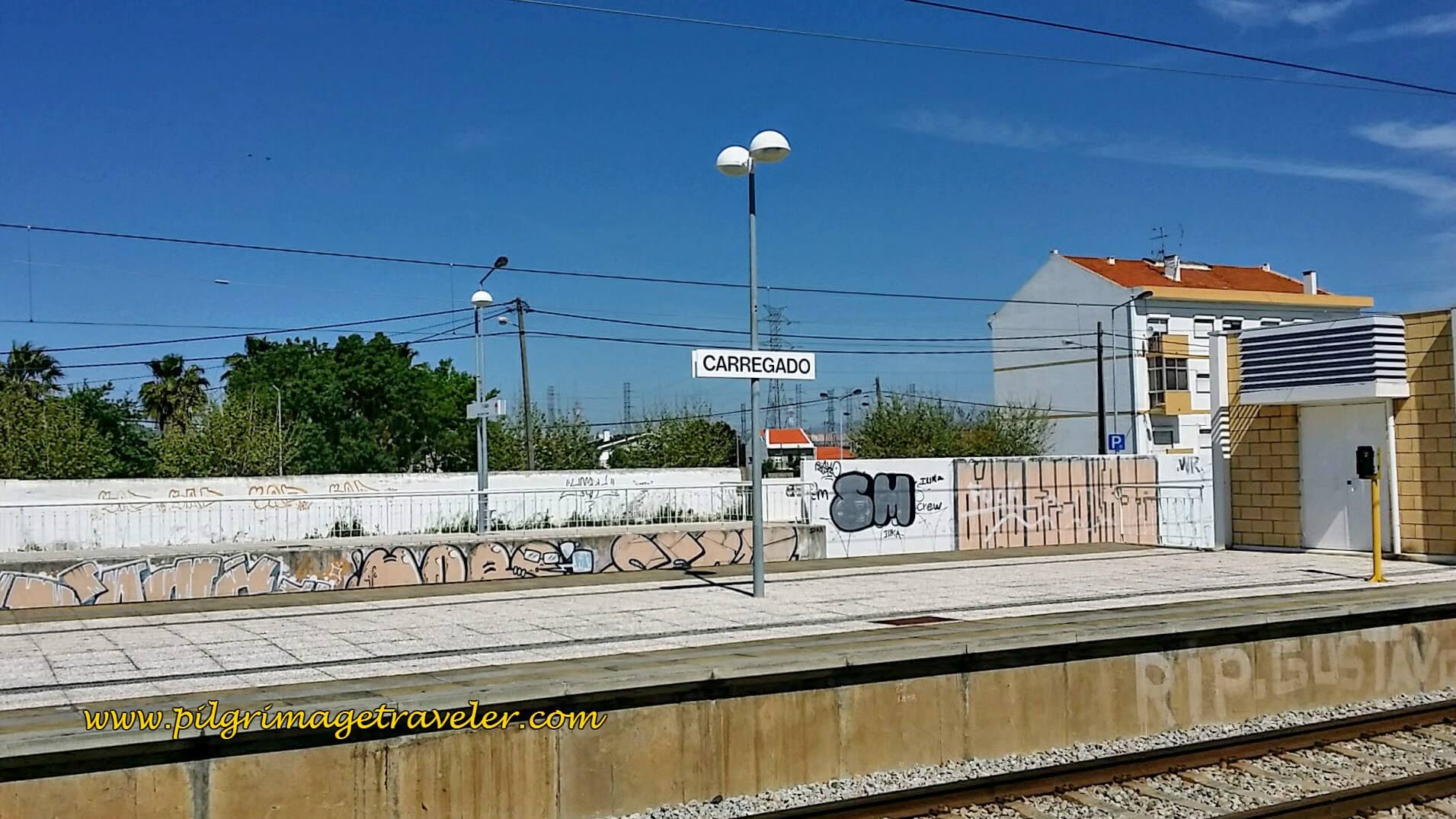 Carregado Train Tracks on Day Two of the Camino Portugués
Carregado Train Tracks on Day Two of the Camino PortuguésIt took us about an hour and a half, to do the approximately 7.0 kilometers on this stretch from Vila Franca to Carregado. It felt like 3 hours!
When you reach the station in Carregado, after about 16.2 kilometers into the day, you need to take an elevator or stairs to go up, over and across the tracks, and then walk down the steps on the other side, to the west of the tracks. We chose the elevator up, but took the stairs down on the other side!
The Way then immediately turns right from the train station, heading northeast on the Rua da Estação towards the Power Plant. If you were to turn left, instead there is a new accommodation on the corner, the Estação Real, if you desire to end your day here.
There are also two cafés on this street, one by the Estação Real and one on the next corner, before you have to turn left onto the Estrada da Vala. After turning to the left, you will now follow the Estrada da Vala, the power plant that had been in our view for what seemed like forever, could now be fully seen. Here it is in all its glory, below.
The Camino follows the Estrada da Vala, along a nice walkway that parallels an irrigation ditch, below.
There are two more cafés along this street and we stopped in one! It was time and it harbored a shady spot to get some respite from the sun. We were ready for another break! All the hot pavement was hurting my feet and I was grateful for a place to stop, rest and air them out!
Rich's right little toe was bothering him, and our Swiss friend, still sticking with us, was starting to complain about the heat.
I had read a poetic little blog, where a group of Sisters did a Camino de Santiago together. One nun described her pilgrimage as "praying with her feet." The only problem with that description for me now, was that my feet didn't feel much like they were in prayer! They were hurting too much, as well as my legs.
At this point we were not yet 2/3 of the way after about 16.5 kilometers into our day two.
Our Swiss friend was the only pilgrim we had seen on day two of the Camino Portugués until Carregado. After our break, we ran into three middle-aged Americans from New England, walking backwards toward the train station. One of the ladies already had a blister!
This was only their third day on the Camino and they were going to take the train from Carregado to Azambuja. They were giving up the pilgrimage for the day! It was discouraging to hear, as our spirits were also a bit down at this point.
While the walk currently had been hot and boring, I set my resolve to walk, come hell or high water!
Jump to Camino Portugués Stages
After leaving Carregado, we turned right onto the Estrada da Central, first crossed a bridge and were faced with 3.5 long kilometers of open, hot pavement once again! Here I am, smiling through the heat! The Way ahead on the open road looks very long, doesn't it?
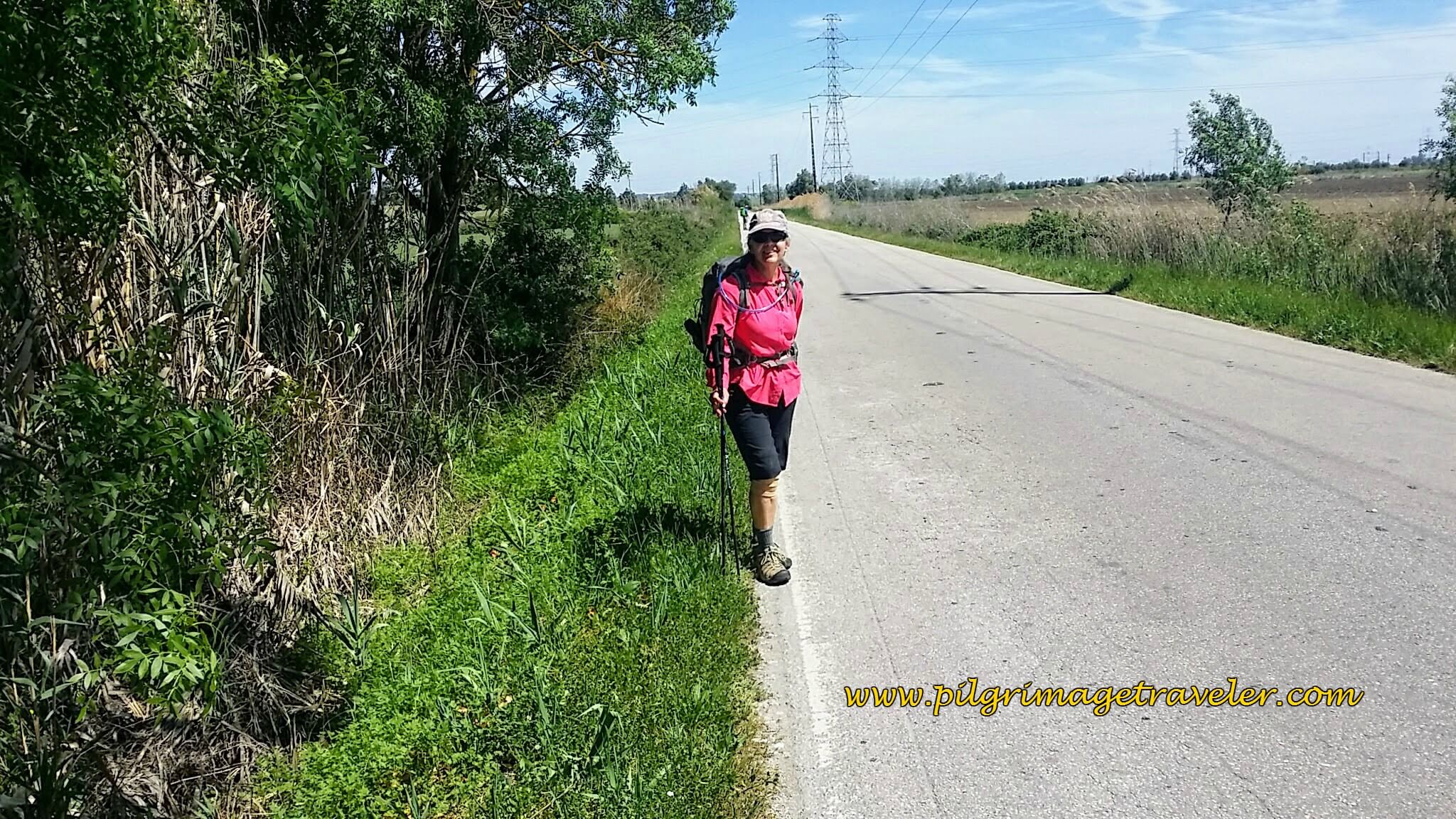 Elle, Along the Estrada da Central
Elle, Along the Estrada da CentralAlong the way we passed a 100 kilometer milestone for Fátima.
After the long pavement section, you will come to a T-intersection with the N3 in the cute little town of Vila Nova da Rainha at approximately 20.7 kilometers into the day. Cross over the N3 and continue on a parallel road. Pass by a picnic area. Here is Rich, walking into town, below.
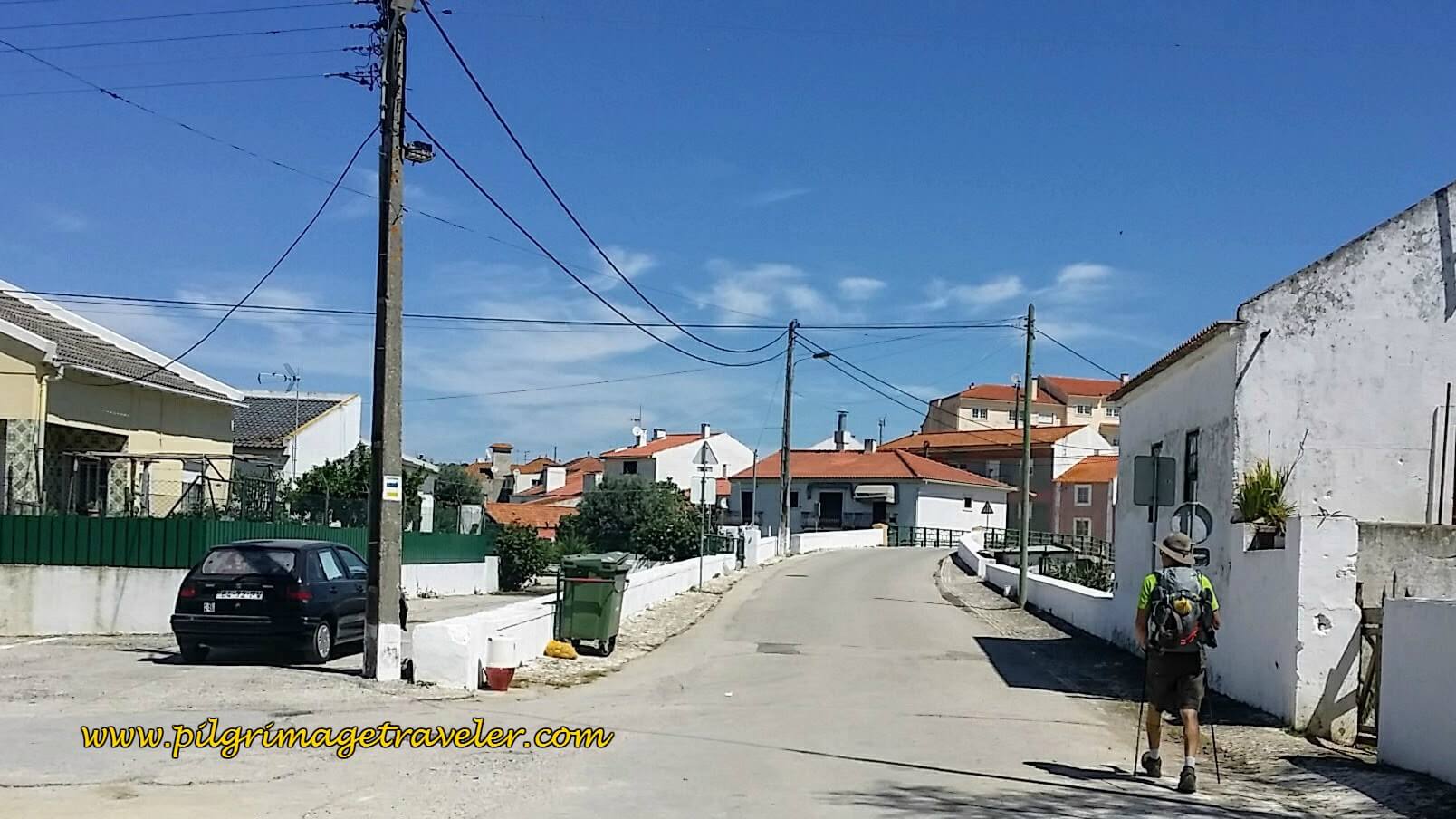 Walking Thru the Town of Vila Nova da Rainha
Walking Thru the Town of Vila Nova da RainhaA few meters onward you will cross the bridge shown next. After the bridge you will turn to the left and walk through the heart of town. We did not stop here, although you will pass by several cafés.
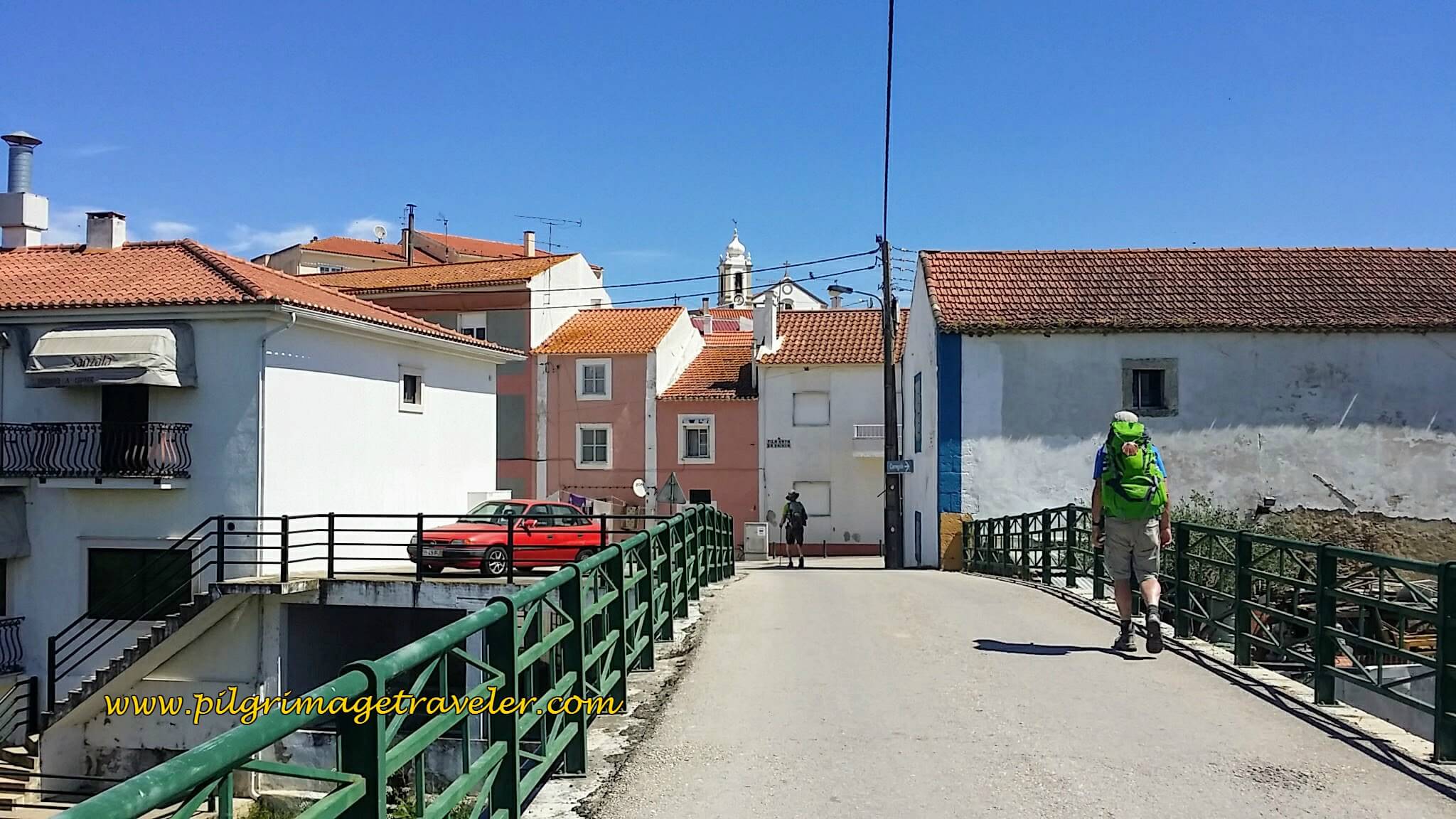 Straggling Over the Bridge Into Town on Day Two of the Camino Portugués
Straggling Over the Bridge Into Town on Day Two of the Camino PortuguésAfter walking through Vila Nova da Rainha, you will take a right hand turn to cross over the N3 once again. After about ¼ kilometer, this street leads you to the Vila Nova da Rainha Train Station, after approximately 21.7 total kilometers.
It was no surprise when we had to walk up and over the train tracks again.
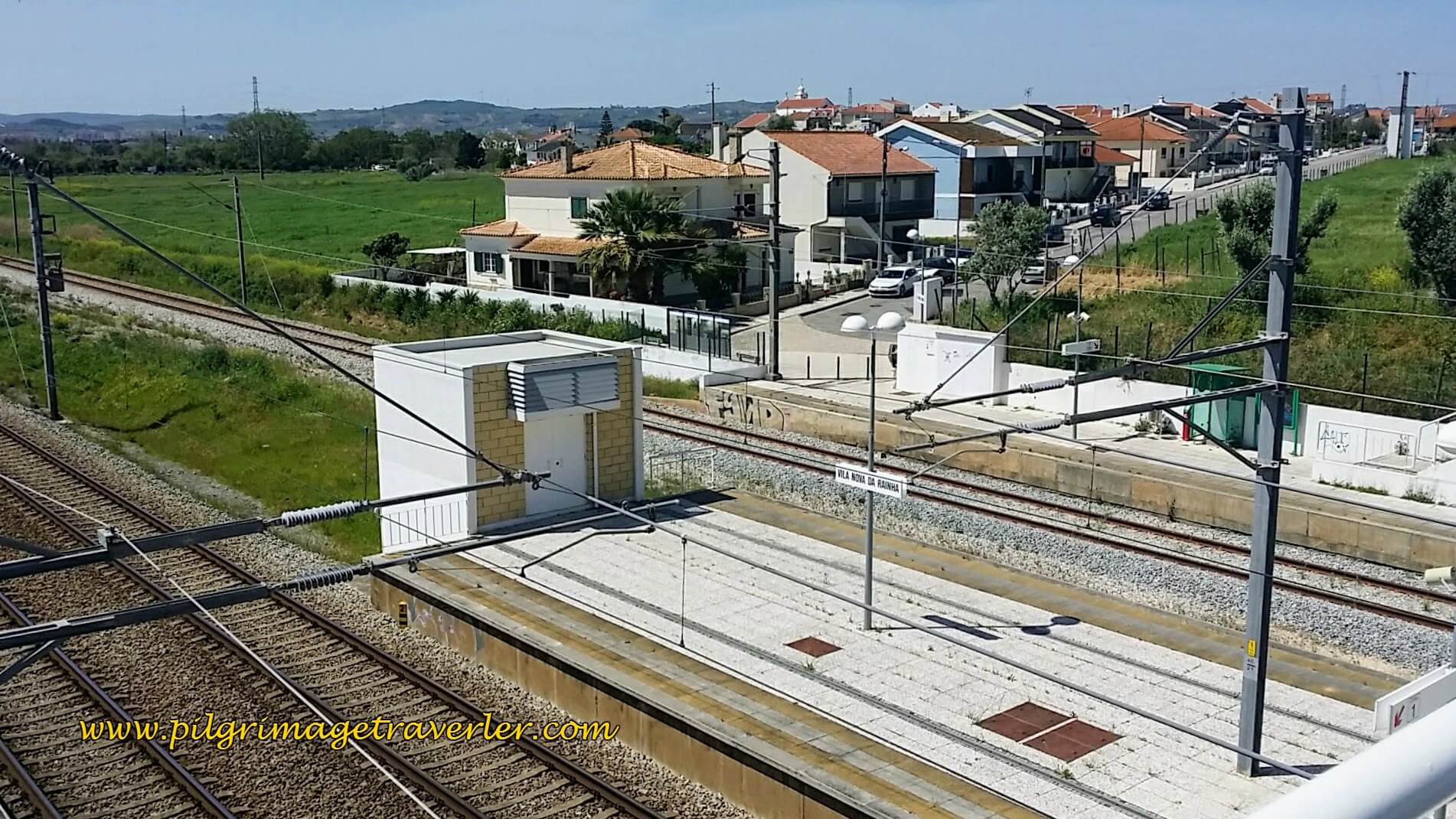 Up and Over the Train Tracks, Once Again in Vila Nova da Rainha
Up and Over the Train Tracks, Once Again in Vila Nova da RainhaImmediately after crossing the tracks, the way turns left onto yet another long, hot, dry and sandy lane, shown below.
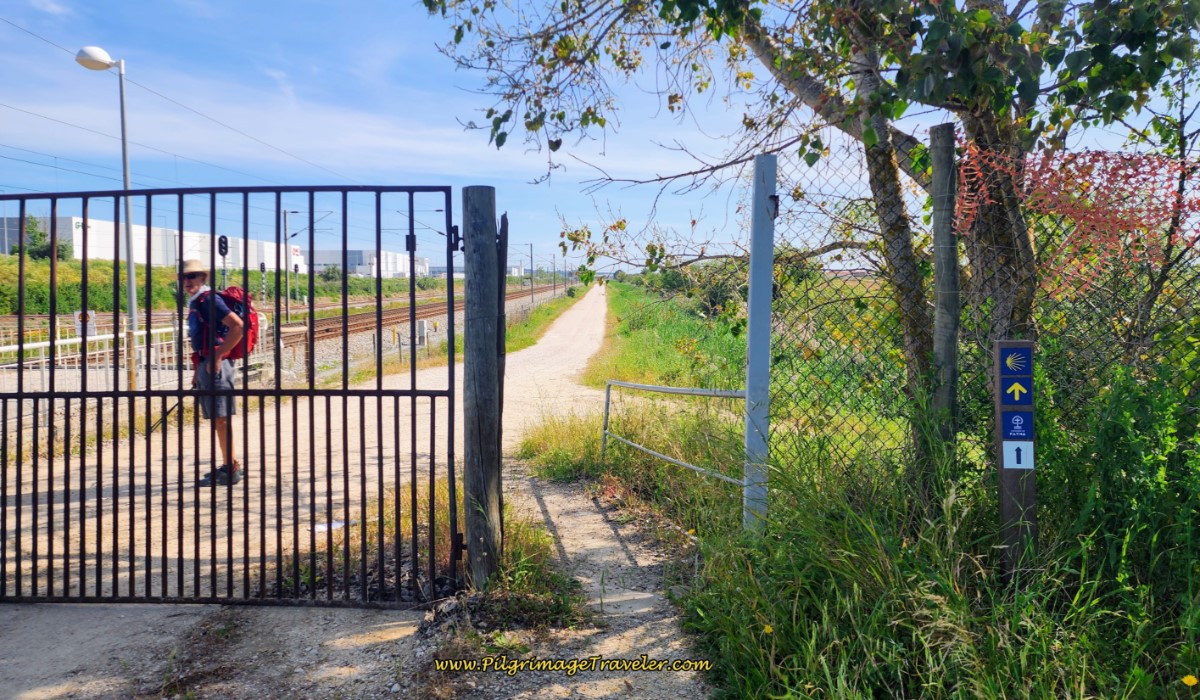 Gate on Sandy Track towards Azambuja
Gate on Sandy Track towards AzambujaAnd of course, the sandy lane follows the railroad tracks going toward Azambuja!
I voice journaled as I walked behind the boys. It was the time of day when in my tiredness, I always reflected and talked to my journal more frequently. This is the time when more complaints were being registered! Or real thoughts without filters. You be the judge!
In my ignorance, I was discouraged to face another long, hot and sandy lane, yet despite it all, I was OK! (It would have been much worse to walk on the hot pavement of the N3 for 6 km from Vila Nova da Rainha into Azambuja, the old way of the Camino!)
I felt like I was struggling to stay hydrated. I felt the constant need to drink. I must have been OK because I had to pee frequently as a result! Not convenient!
The sun was brutal and I noticed that the back of our Swiss friend's legs were totally sunburnt. I don't suppose his heavy pack carried sunscreen. I offered him some, which he graciously accepted.
I was tired of the railroad tracks. Seemed to me, in these early stages, that there was not a lot of pilgrimage history here, and the medieval route of yore was not well-established. There were no frequent chapels along the way to remind you to say a prayer or express gratitude. I missed this.
While the scenery in the afternoon was boring, at least it was flat, and required less exertion in this heat! I was so tired of the heat! I even called it my "desert Camino!" One foot in front of the other...
I reflected that the Portuguese did not seem as friendly as the Spaniards. The greetings along the path today were infrequent. If I engaged first, they were always friendly in return. A little bit of my Spanish/Portuguese did seem to help break the ice. Perhaps describing them as reserved, is more appropriate.
I reflected on the loneliness here thus far. Aside from our Swiss friend, we were out here all alone. No real community feeling was part of this Camino yet. In fact we were tiring of our Swiss friend. He stuck to us like glue. So much, that I nicknamed him the Barnacle. In an irreverent way, Rich and I continued to call him by this name, when we spoke in private. Sad, but true.
After about 3.0 hot kilometers, and 24.5 kilometers total for the day, we arrived at the train station prior to Azambuja, the Espandanal de Azambuja, shown below. This is where the old way used to cross the tracks, walking through an industrial area and eventually joining the N3 for the final, brutal 2.5 km walk into town.
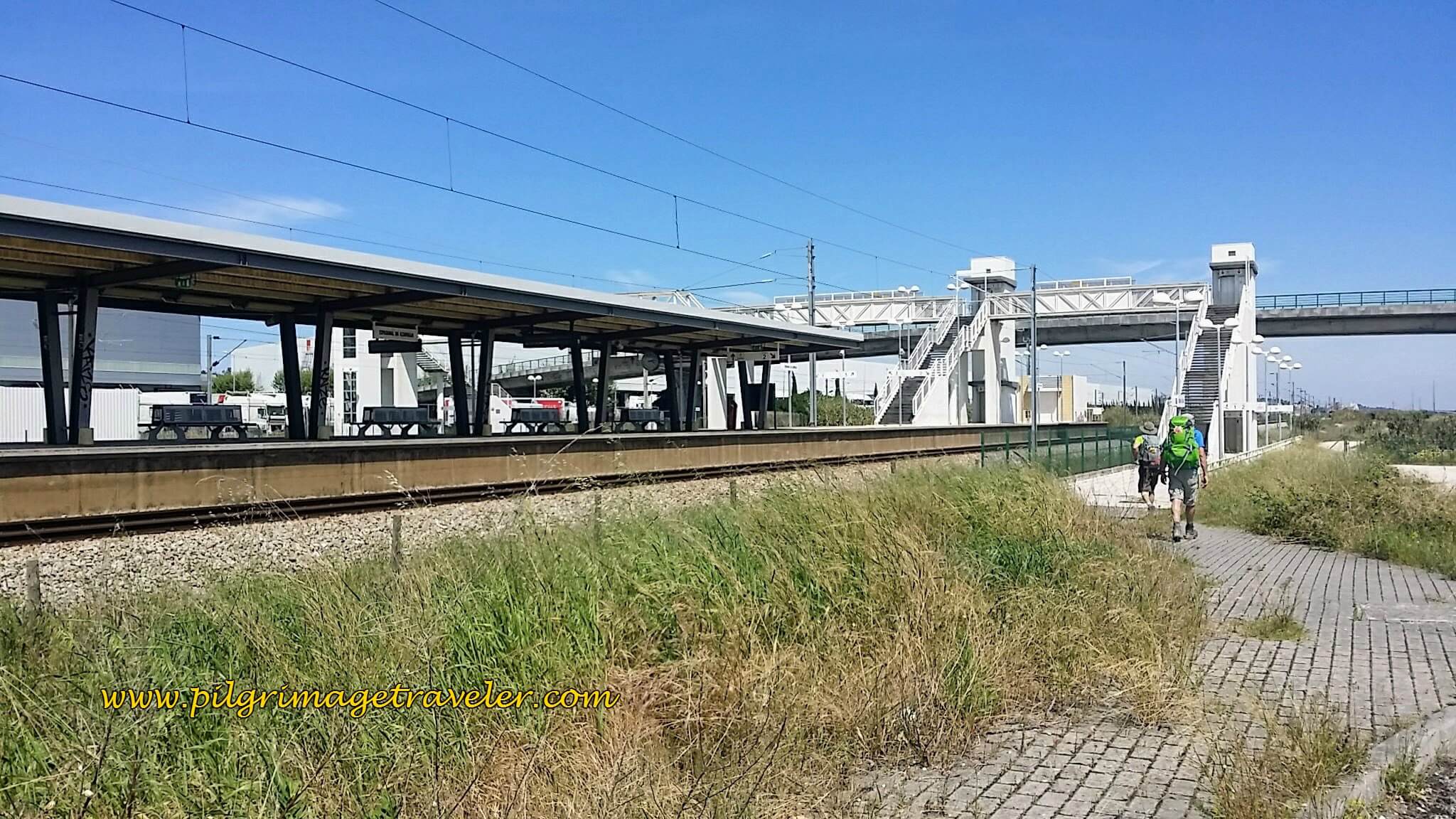 Espadanal de Azambuja Train Station
Espadanal de Azambuja Train StationFortunately, the Way has been re-routed, and you pass the Espandanal de Azambuja train station, and stay on the dirt lane for about another 2.7 kilometers. Along the way the lane becomes rougher, passing a water treatment area where it is now only a 2-track lane. Eventually by 27.2 kilometers it now becomes a path and makes an abrupt turn to the left to walk under the railroad tracks, below.
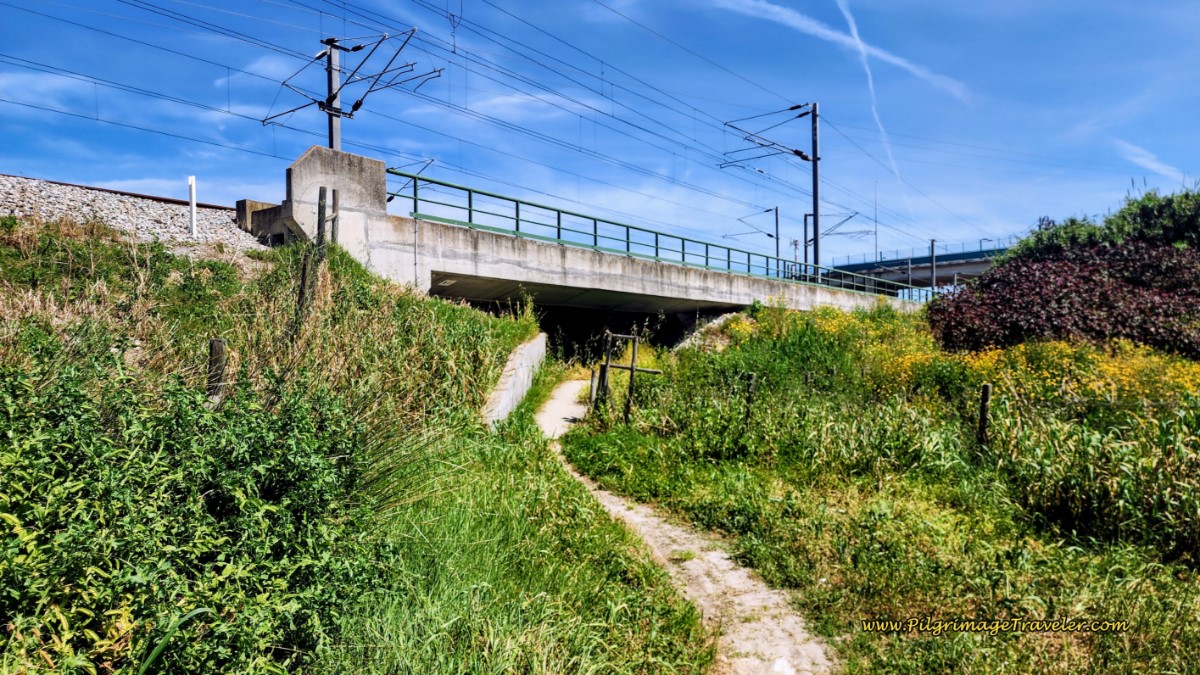 Walk Under the Railroad Tracks on a Path
Walk Under the Railroad Tracks on a PathThe path continues for about ¼ kilometer and as you walk along you can see the Ouro Hotel and Restaurant (+351 263 406 530) on your right.
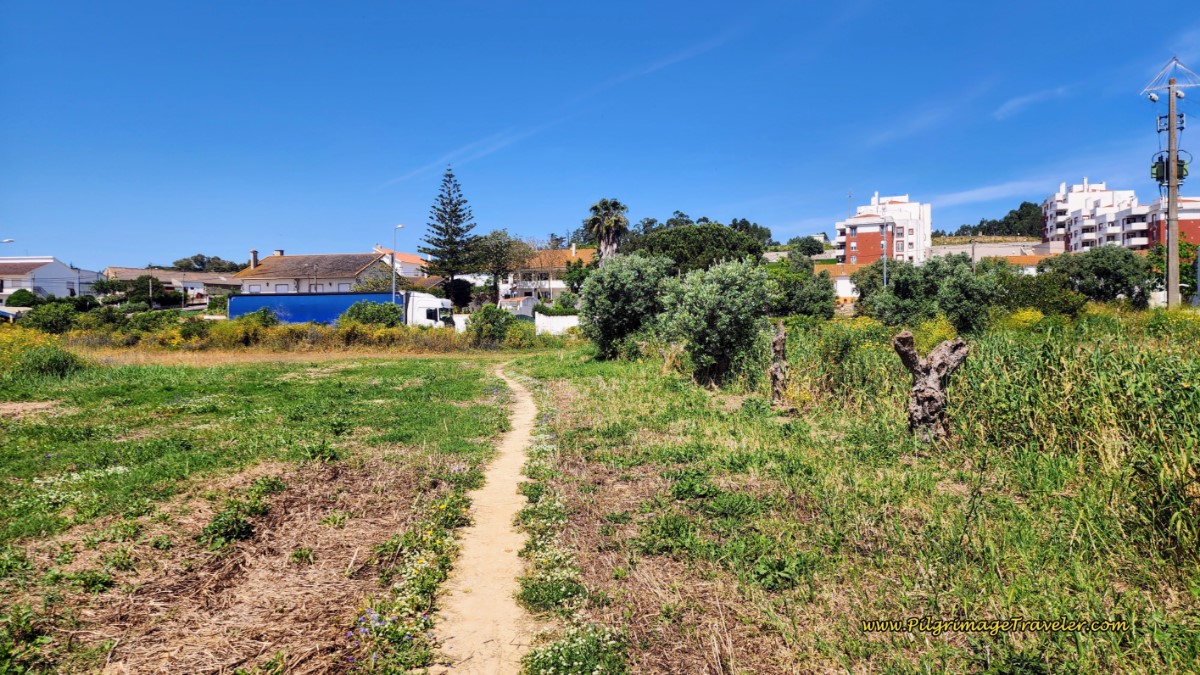 The Path Leads into Azambuja
The Path Leads into AzambujaThe path ends when it reaches Azambuja at a T-intersection with the N3. You will turn right onto the N3 at the Azambuja sign.
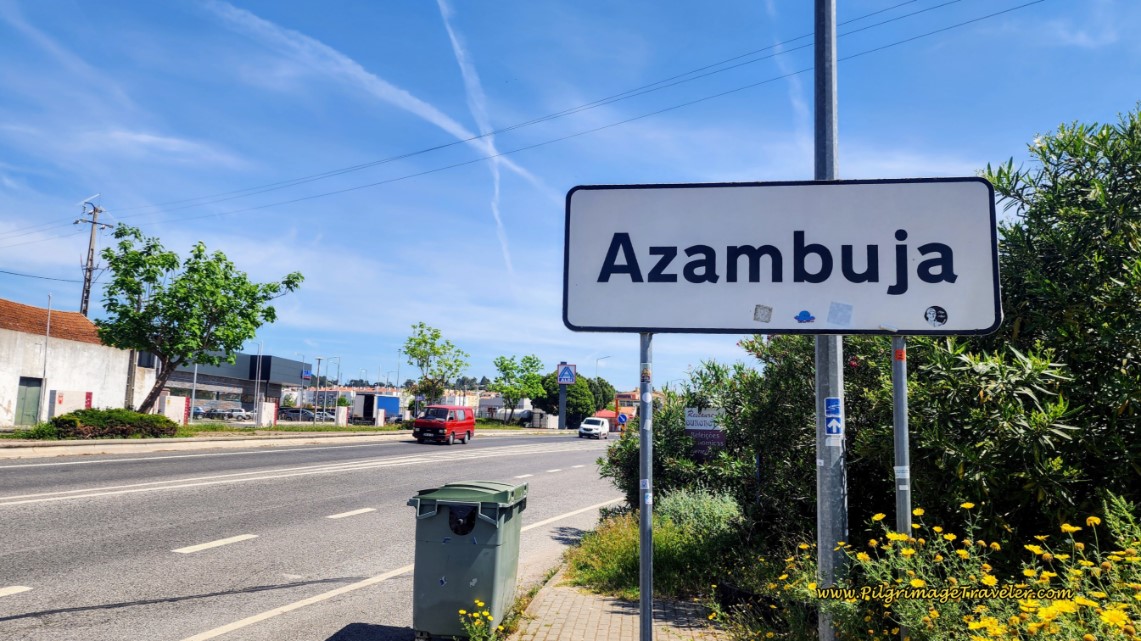 Right Turn onto the N3 into Azambuja
Right Turn onto the N3 into AzambujaThis way is not really more beautiful than walking through the industrial area of Azambuja, but it is certainly safer!
Next, you walk a few meters to the next roundabout, turning to the left. A few more meters later, the next intersection is a very large roundabout, where you will turn to the right to pick up the Avenida do Valverde, which takes you into town, below.
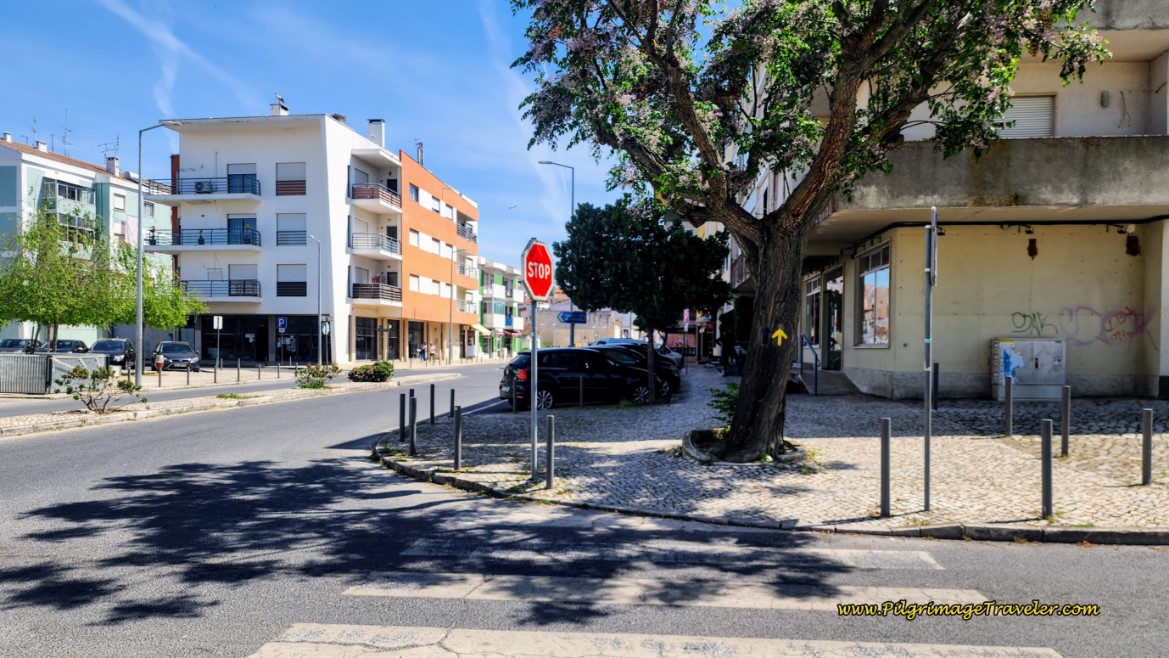 Avenida do Valverde into the Center of Town
Avenida do Valverde into the Center of TownMy one foot in front of the other, had brought me here at last.
In only about 1/2 kilometer as you enter into town, you will pass your first accommodation, the pension, Casa da Rainha, right along the Camino. In another 150 meters the Camino takes a right turn and onto the Rua Arouca, see next photo, and walks by the Residential Flor da Primavera. This is where we chose to stay.
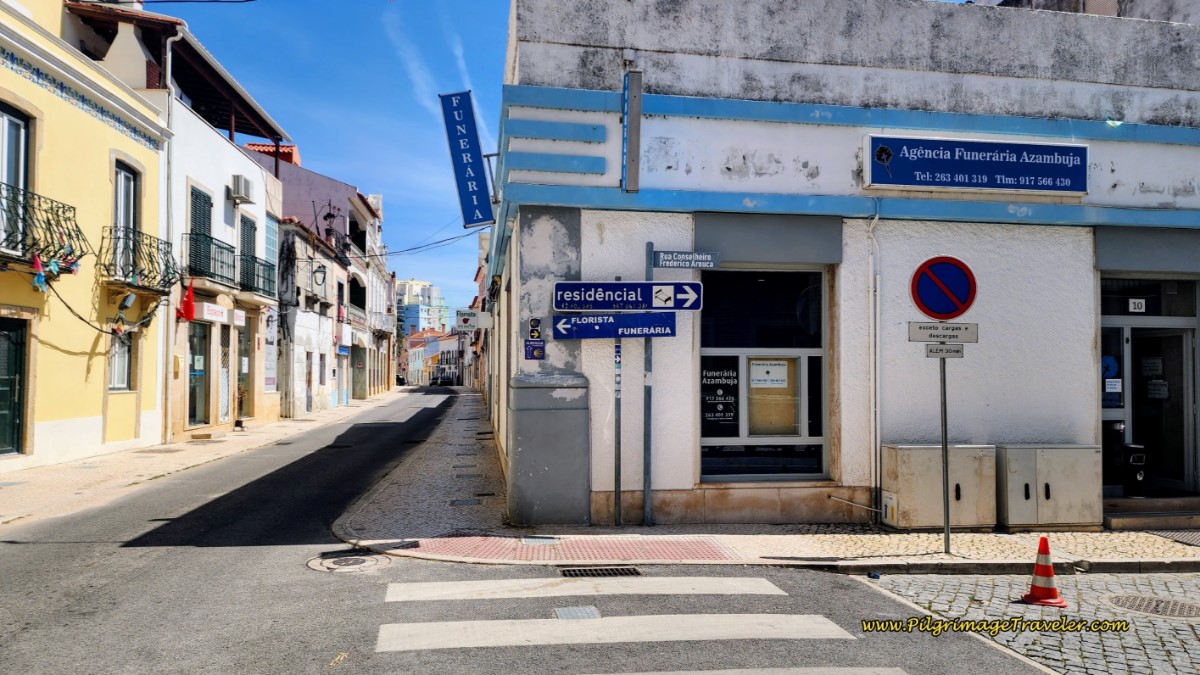 Right Turn Here Towards the Azambuja Train Station
Right Turn Here Towards the Azambuja Train StationHowever, if you continue on straight at the intersection the Albergue de Peregrinos de Azambuja or the Abrigo do Peregrino is ahead another one block, phone number, +351 914 103 807. Click here for their Facebook page.
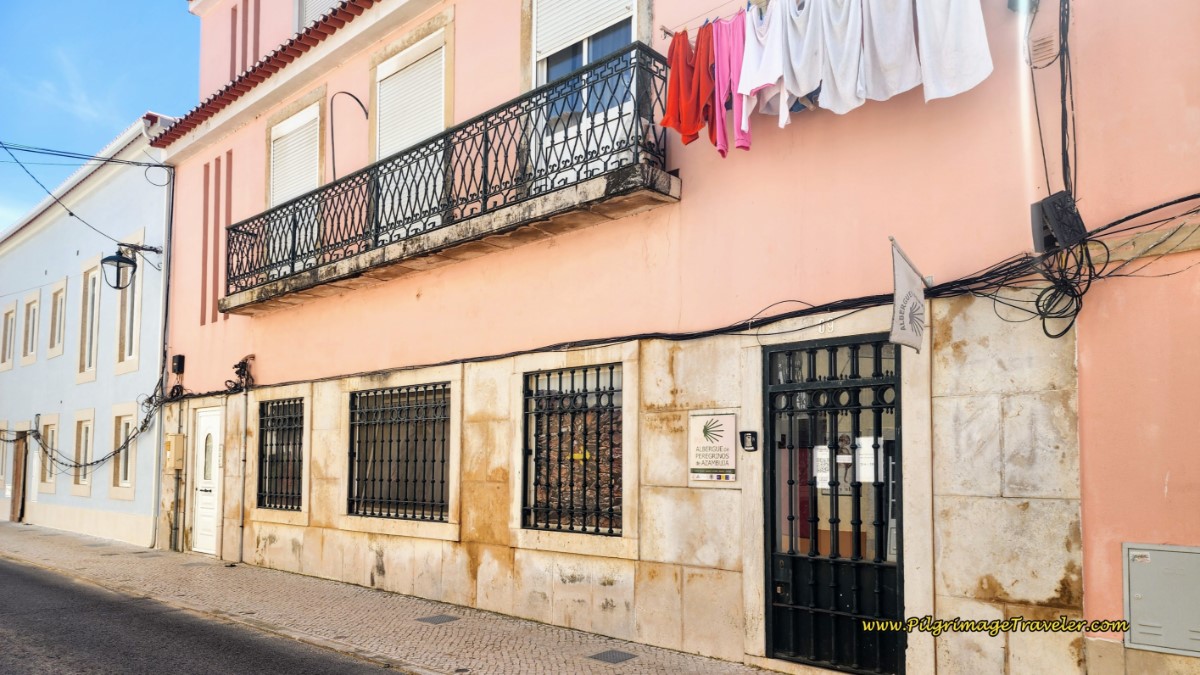 Albergue de Peregrinos de Azambuja
Albergue de Peregrinos de AzambujaThe Flor da Primavera was a comfortable family hotel, clean and with a very friendly proprietress who will hang your hand-washed clothes up on her roof, if you ask her. The cost for a lovely room with its own bath is very economical.
We hoped to go to a grocery store, but alas it was Sunday, and all the stores were closed! I needed to replenish my pack with snacks, but it would have to wait until Monday.
Our proprietress recommended a café just down the street, where she said we could get food anytime. Yay! We cleaned up, washed our clothes and went post haste to the café by 4 o'clock. (This café is now closed, but there are many more!)
We ran into the three New England pilgrims and were told that tomorrow's leg, at Porto Muge, 15 km down the road, was completely booked for a Portuguese event. Our only choice was to make it to Santarém at 33 km. Or take a train back and forth as needed.
I was worried about our Swiss friend. He looked pretty trashed, and told us he did not want to walk to Santarem tomorrow. We decided that we would see how we felt in the morning.
We were served by a very informative English-speaking man whose mother owned the café. I had an amazing stewed goat dish, marinated in red wine for two days. The man introduced us to Aguardente, the Portuguese firewater! He said the name means "fire in the belly" and indeed, that is its very effect. He said it was good for the "recuperation" and yes, of course, it was!
My favorite, however, was when he introduced to us, on the house, yet another famous Portuguese aperitif, called Ginja (said like jzhin jzha), a sweet cherry-flavored liquor. I loved it.
We all ate and drank heartily and sealed our day two's experience on the Camino Portugués. We learned that the café would also open up at 7:00 a.m., just for pilgrims, so we agreed to meet there in the morning.
We fell into bed, exhausted, sated and content, at 7:30 p.m.
Lessons Learned on Day Two, Camino Portugués
Persistence is the name of the game for this leg of the Camino. Bring music, or chat with someone, drink lots of water, and take as many breaks as you need. Our rule of thumb is to stop about every 10 kilometers, eat something, and air out our feet! Always one foot in front of the other!
Salutation
May your own day two on the Camino Portugués be filled with resolution, persistence and hope! May you always continue when the going gets rough, with one foot in front of the other, slowly and surely!
Camino Portugués Overview
Camino Portugués Stages
Central Route: Lisbon to Porto Stages
Central Route: Porto to Santiago Stages
Senda Litoral or the Coastal Routes: Porto to Santiago Stages
Skip to Central Route Above, for Final Days 22-25 to Santiago
Variante Espiritual Stages
Please Consider Showing Your Support
Many readers contact me, Elle, to thank me for all the time and care that I have spent creating this informative website. If you have been truly blessed by my efforts, have not purchased an eBook, yet wish to contribute, I am exeedingly grateful. Thank you!
Search This Website:
🙋♀️ Why Trust Us at the Pilgrimage Traveler?

We’re not a travel agency ~ we’re fellow pilgrims! (See About Us)
We've trekked Pilgrimage Routes Across Europe since 2014!
💬 We’ve:
- Gotten lost so you don’t have to. 😉
- Followed waymarks in the glowing sunlight, the pouring rain and by moonlight. ☀️🌧️🌙
- Slept in albergues, hostels & casa rurals. Ate and drank in cafés along the way. 🛌 😴
- Created comprehensive and downloadable GPS maps and eBook Guides, full of must-have information based on real pilgrimage travels. 🧭 🗺️
- Shared our complete journeys, step by step to help YOU plan your ultimate pilgrimage and walk with your own Heart and Soul. 💙✨
Every detail is from our own experiences. Just fellow pilgrims sharing the Way. We have added a touch of spirituality, heartfelt insights and practical guidance from the road ~ offering a genuine connection to the spirit of pilgrimage. Tap into the wisdom of seasoned pilgrims!
Ultreia and Safe Pilgrimage Travels, Caminante! 💫 💚 🤍
Follow Me on Pinterest:
Find the Pilgrimage Traveler on Facebook:
Like / Share this page on Facebook:
***All Banners, Amazon, Roamless and Booking.com links on this website are affiliate links. As an Amazon associate and a Booking.com associate, the Pilgrimage Traveler website will earn from qualifying purchases when you click on these links, at no cost to you. We sincerely thank you as this is a pilgrim-supported website***
PS: Our eBook Guide books are of our own creation and we appreciate your purchase of those too!!
Shroud Yourself in Mystery, along the Via de Francesco!
Walk in the Footsteps of St. Francis, and Connect Deeply to the Saint and to Nature in the Marvelous Italian Countryside!
Need suggestions on what to pack for your next pilgrimage? Click Here or on the photo below!
Find the Best Hotel Deals Using This Tool!
Carbon Trekking Poles ~ My Favorites!
Carbon fiber construction (not aluminum) in a trekking pole makes them ultra lightweight. We like the Z-Pole style from Black Diamond so we can hide our poles in our pack from potential thieves before getting to our albergue! There are many to choose from! (See more of our gear recommendations! )
Gregory BackPack ~ My Favorite Brand
Do not forget your quick-dry microfiber towel!

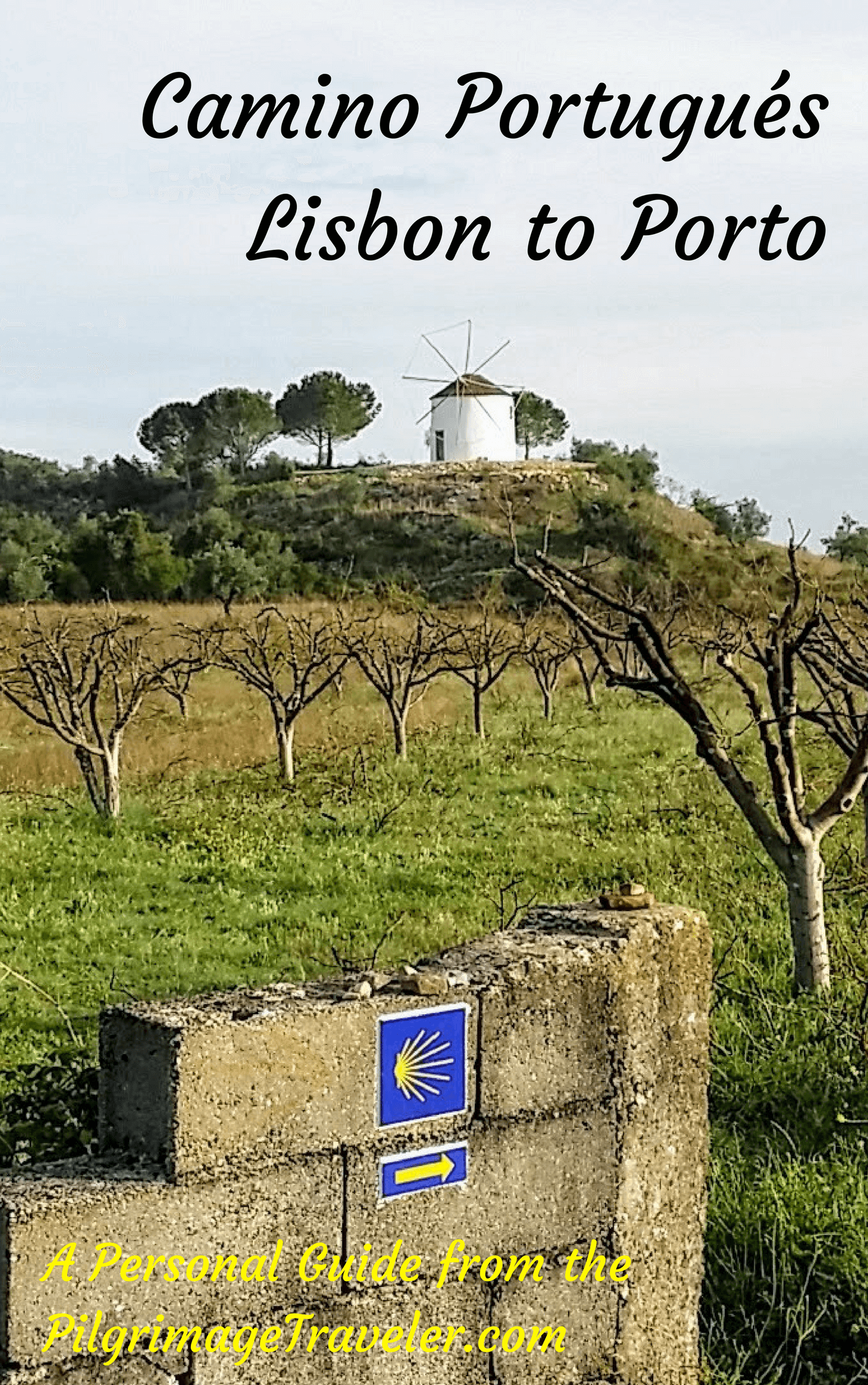
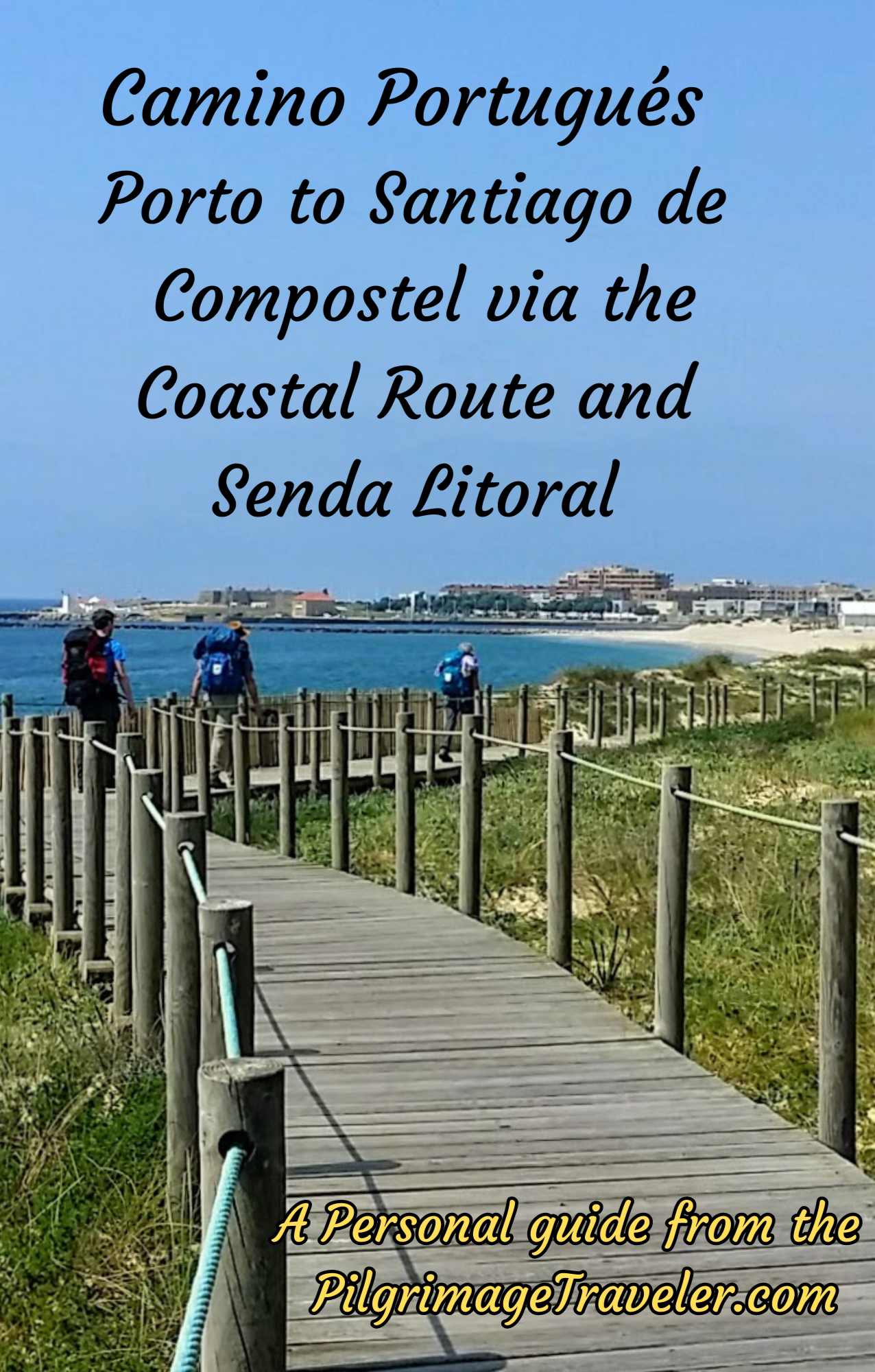
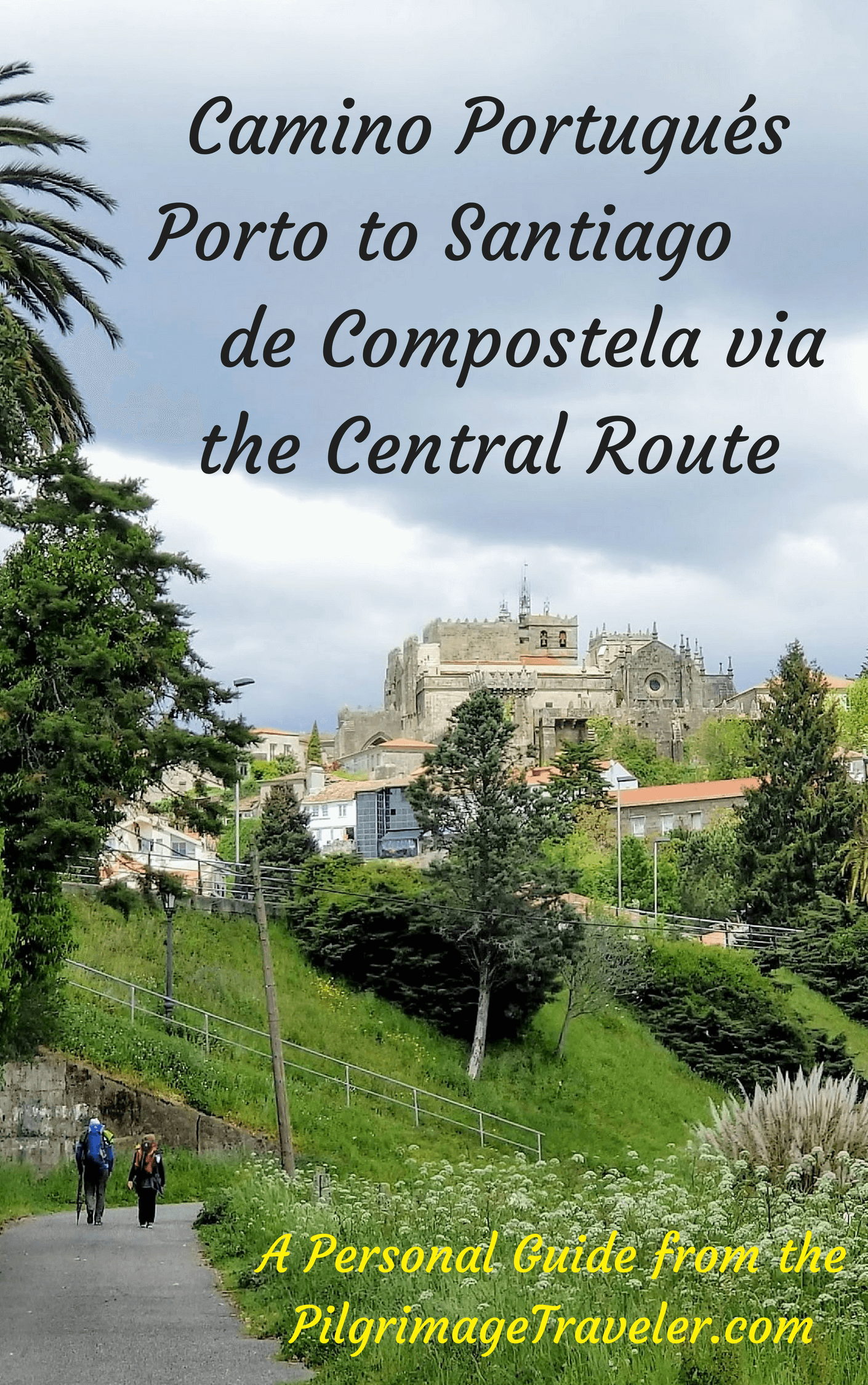
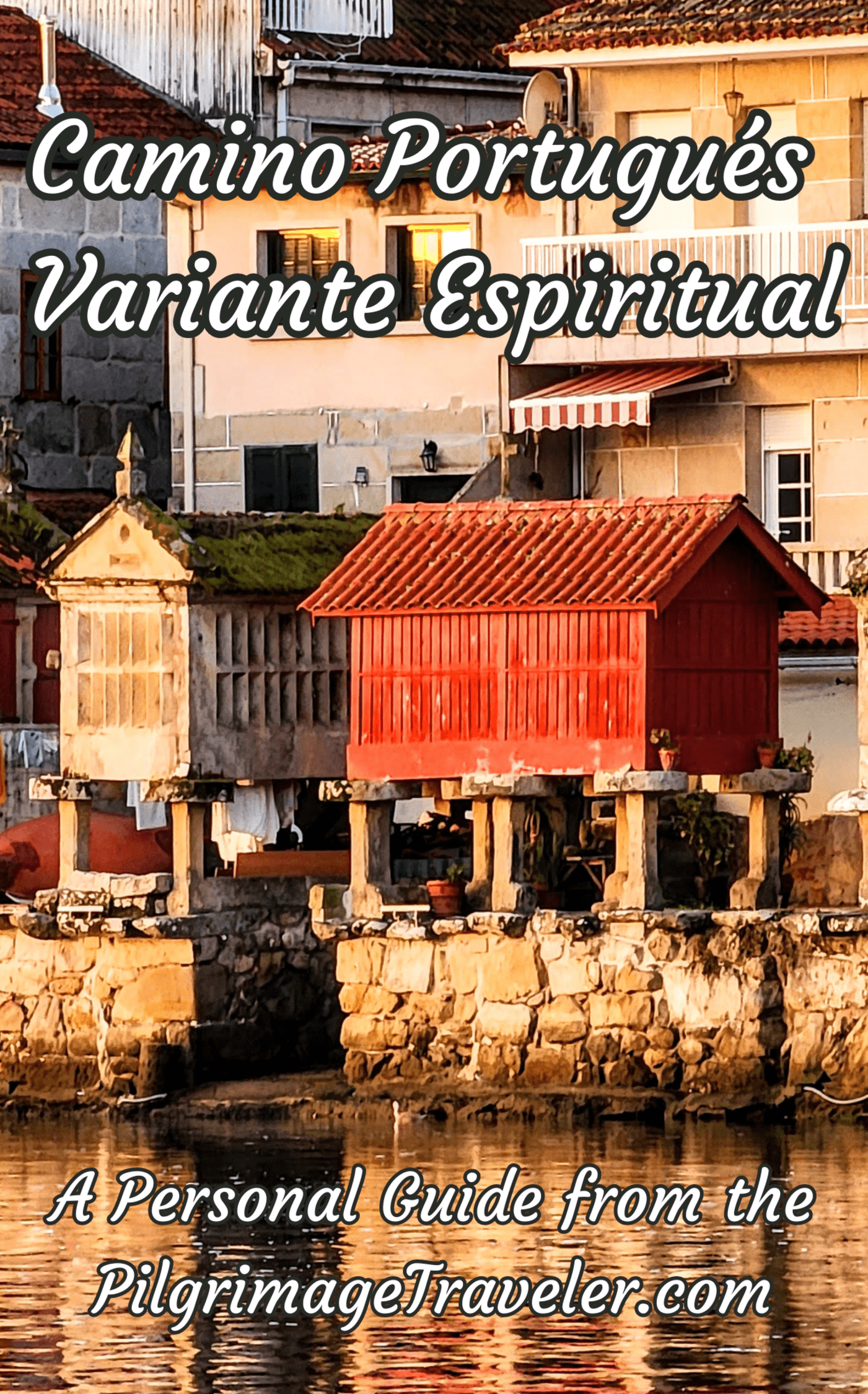
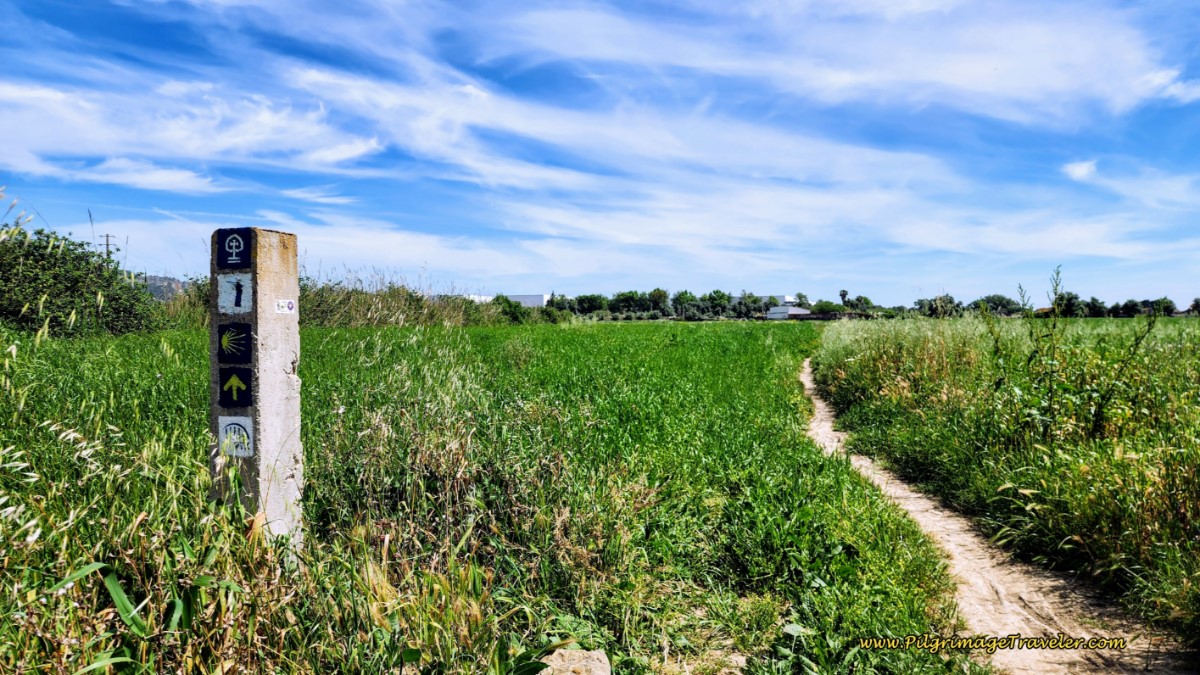
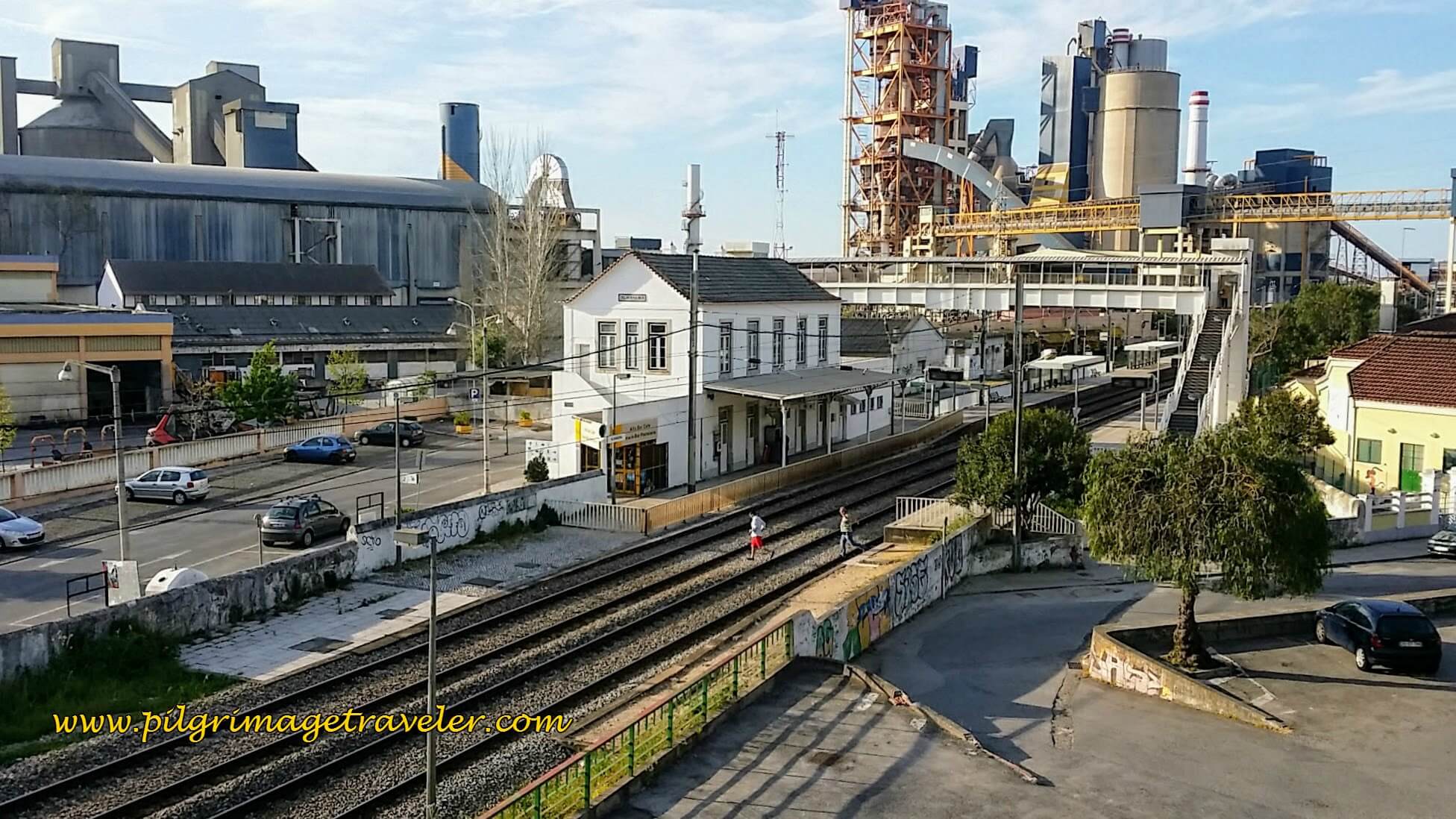
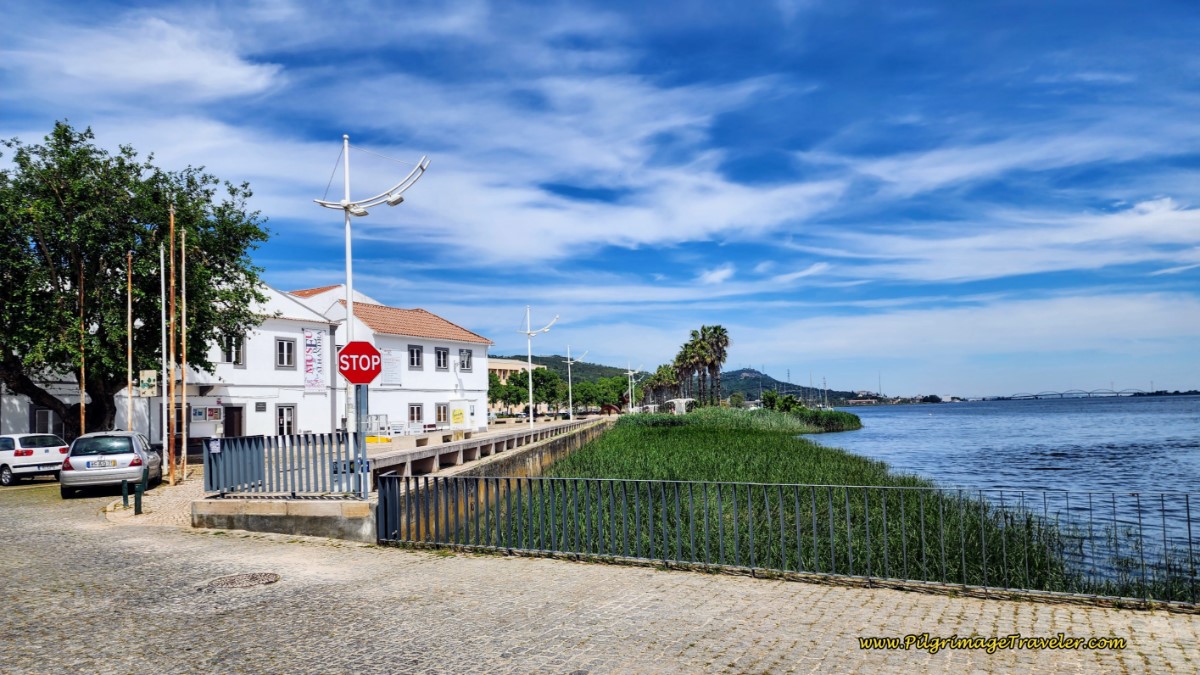
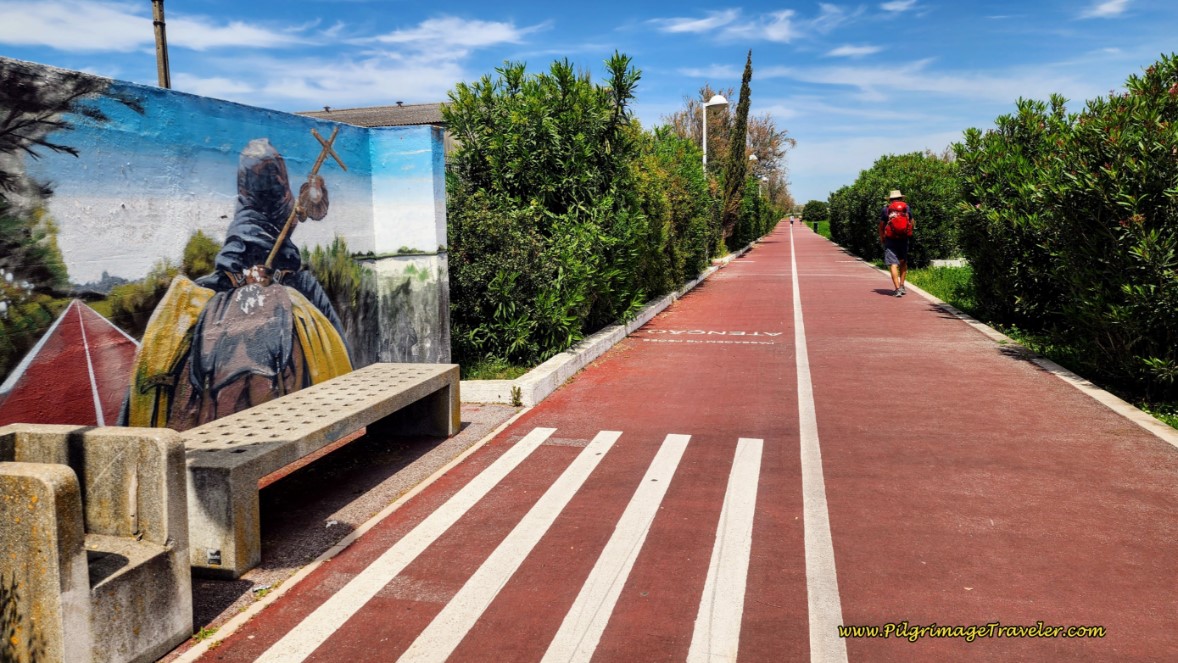
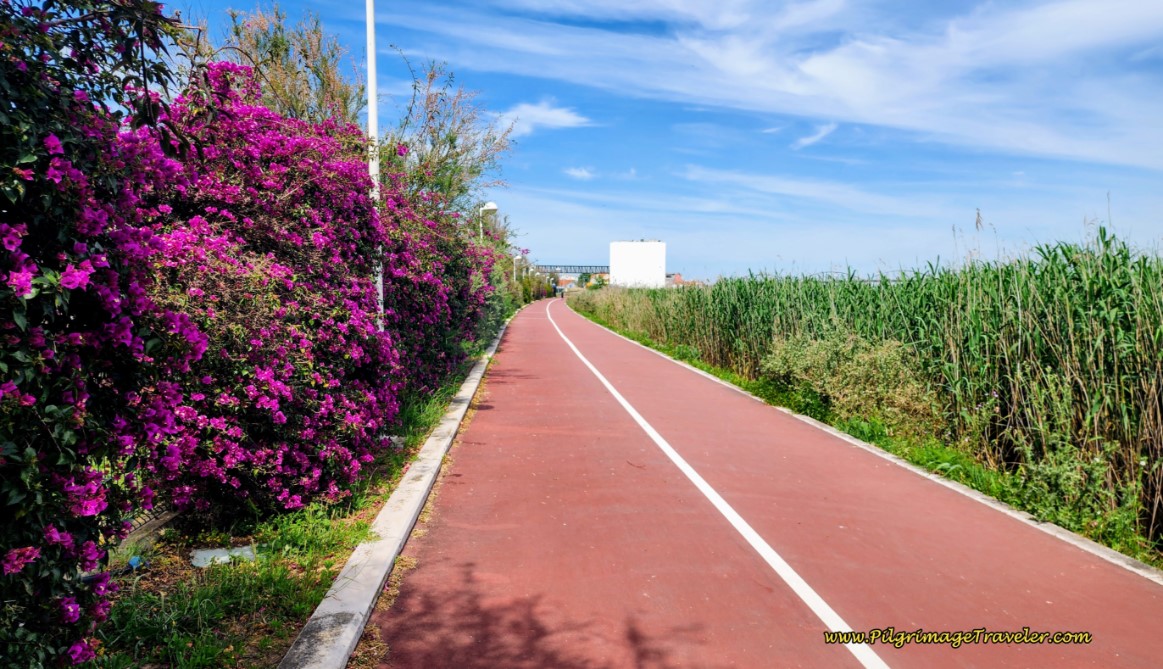
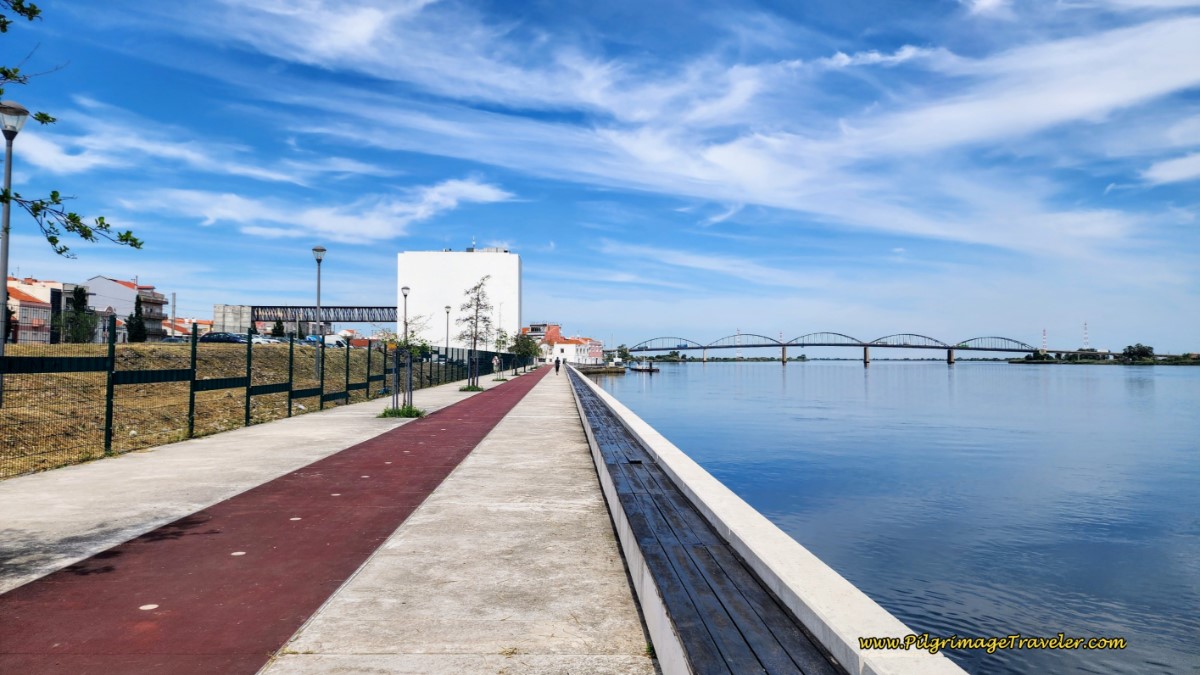
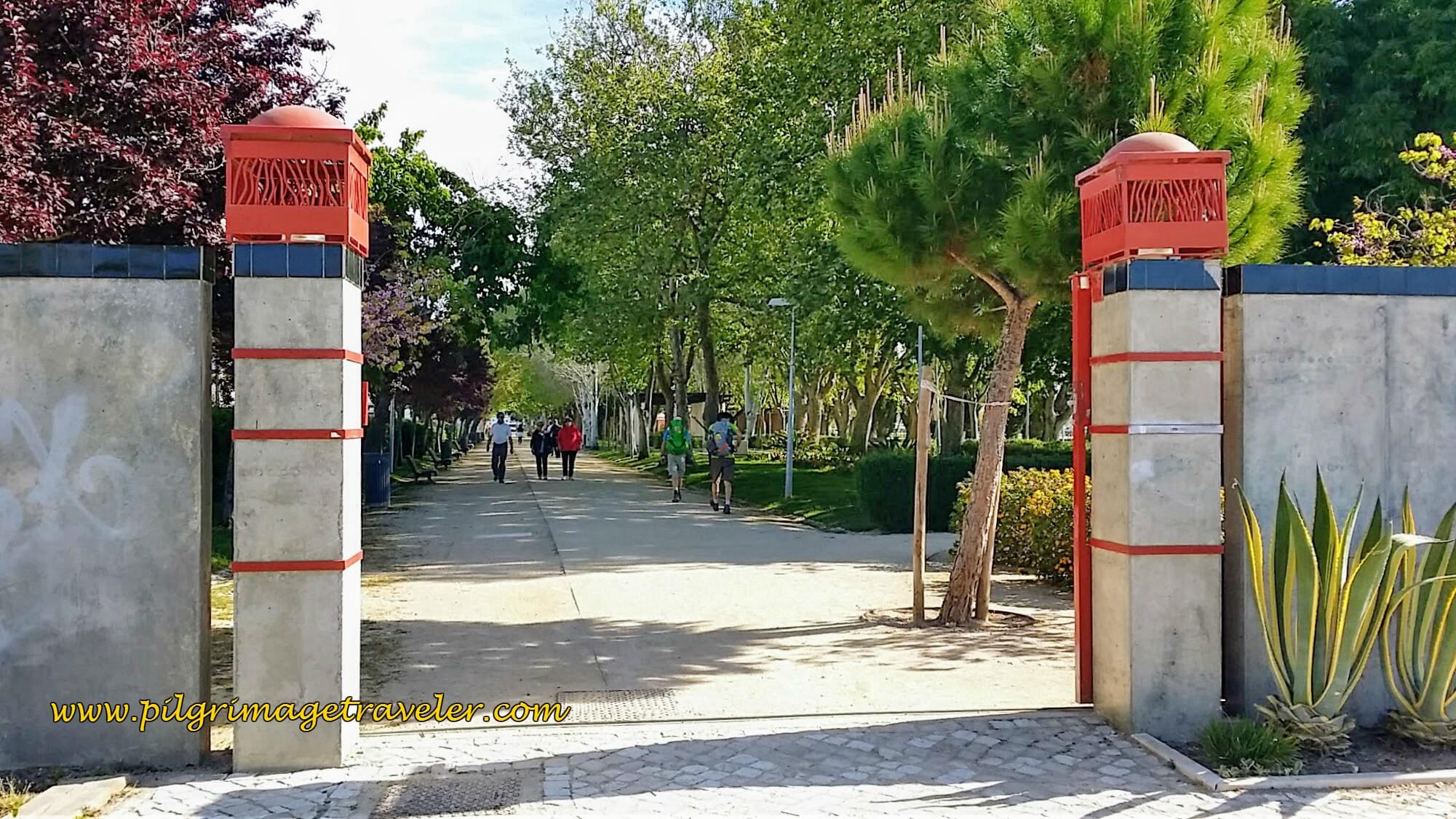
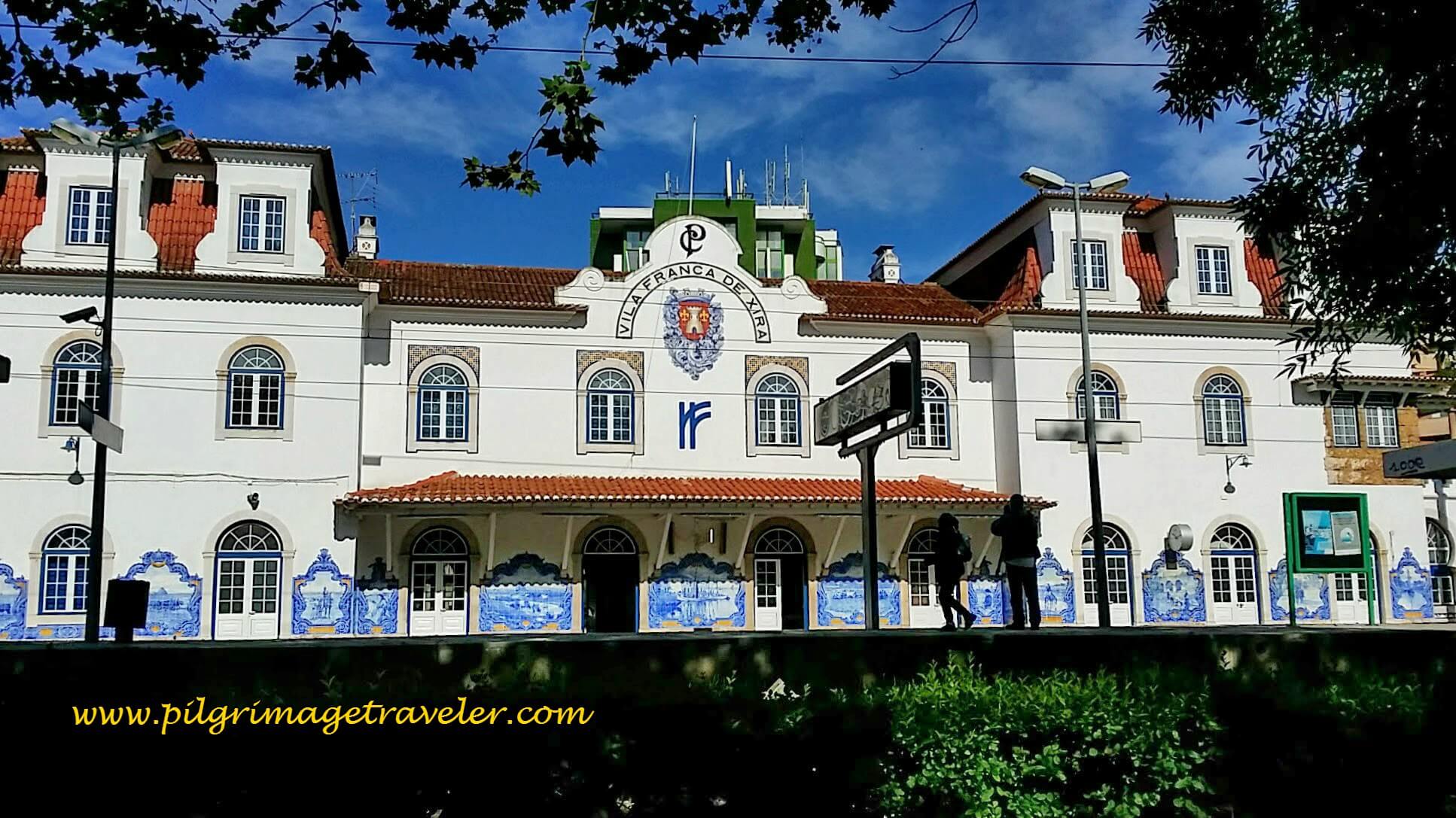
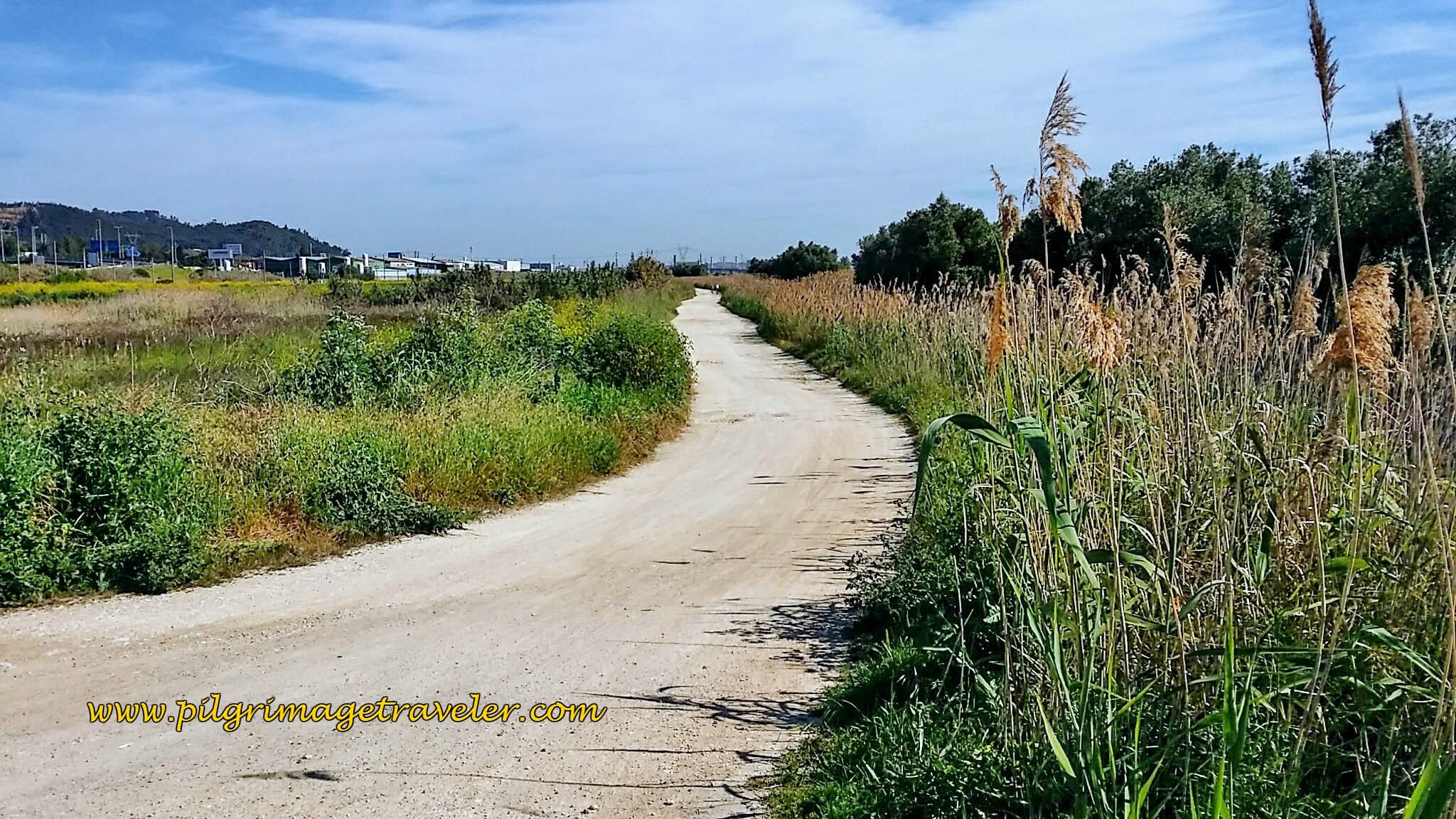
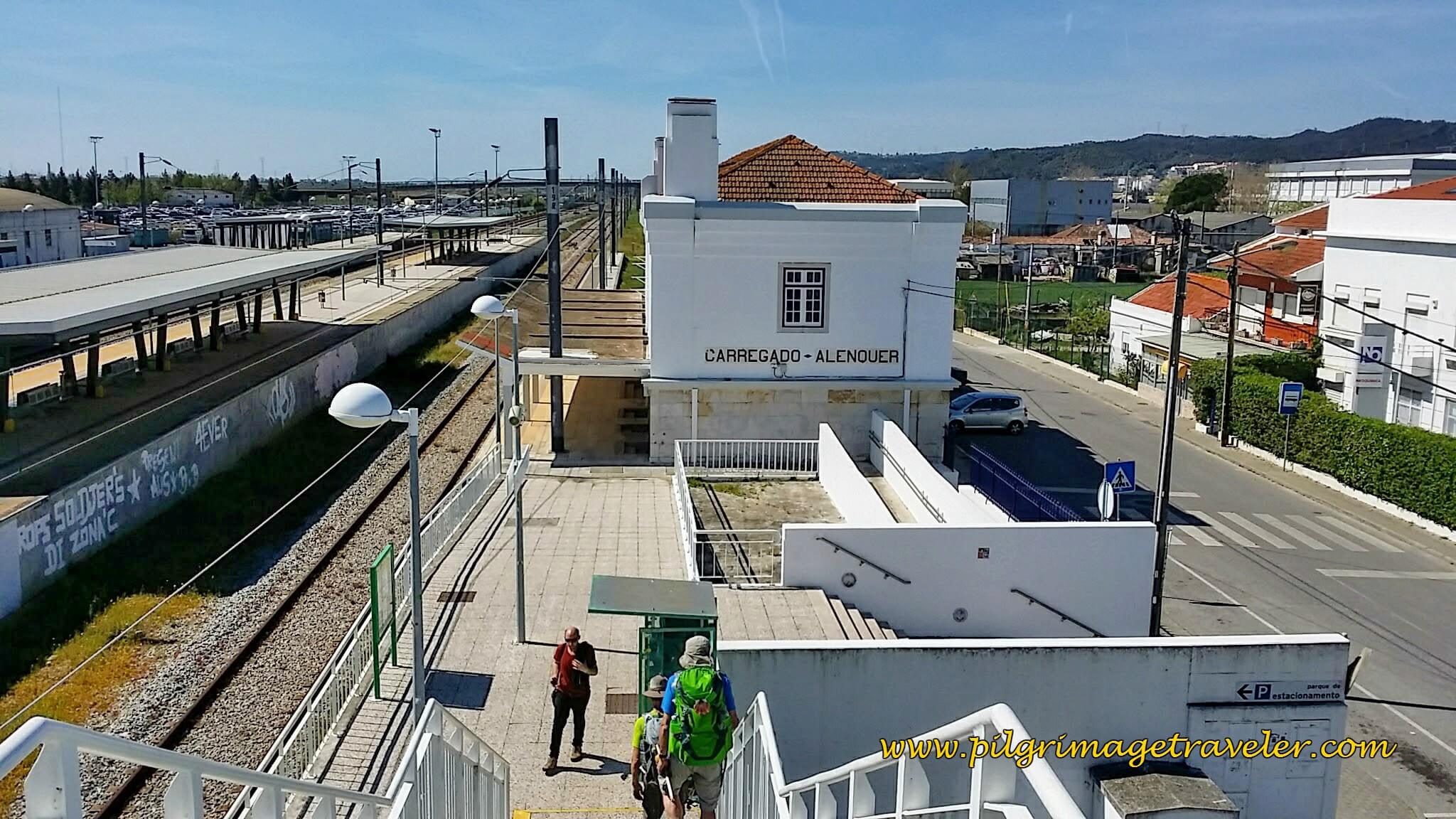
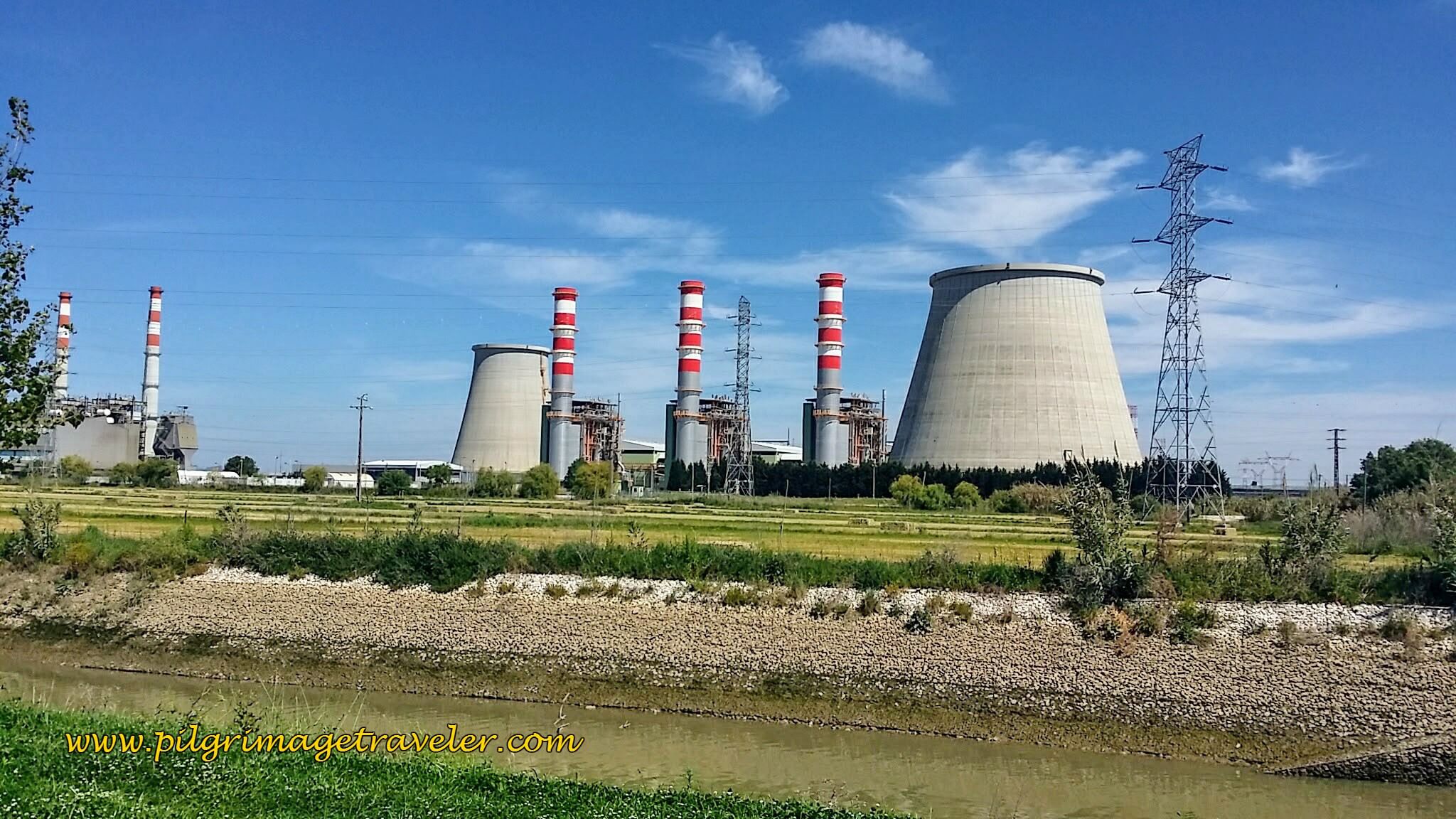
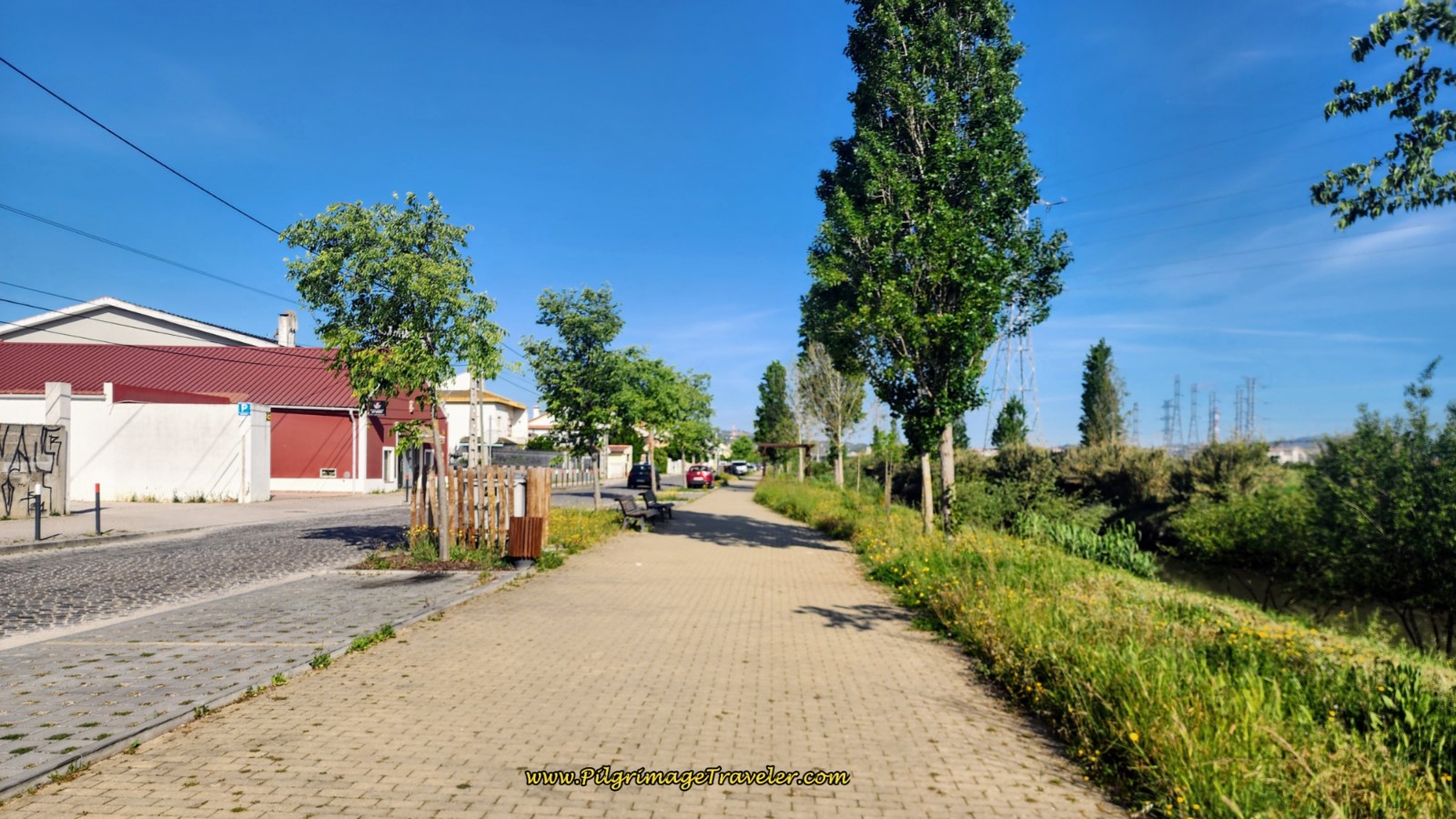
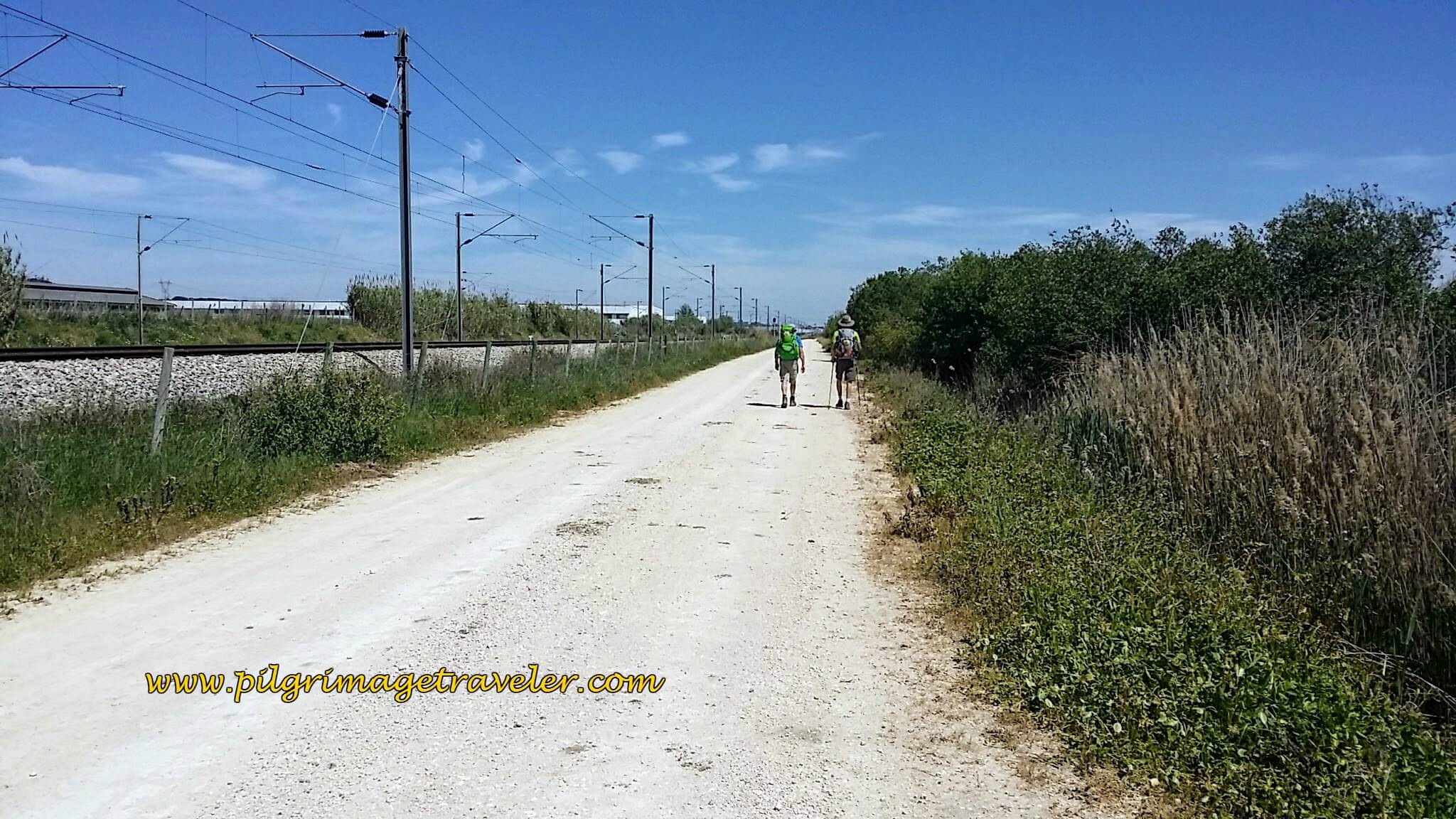





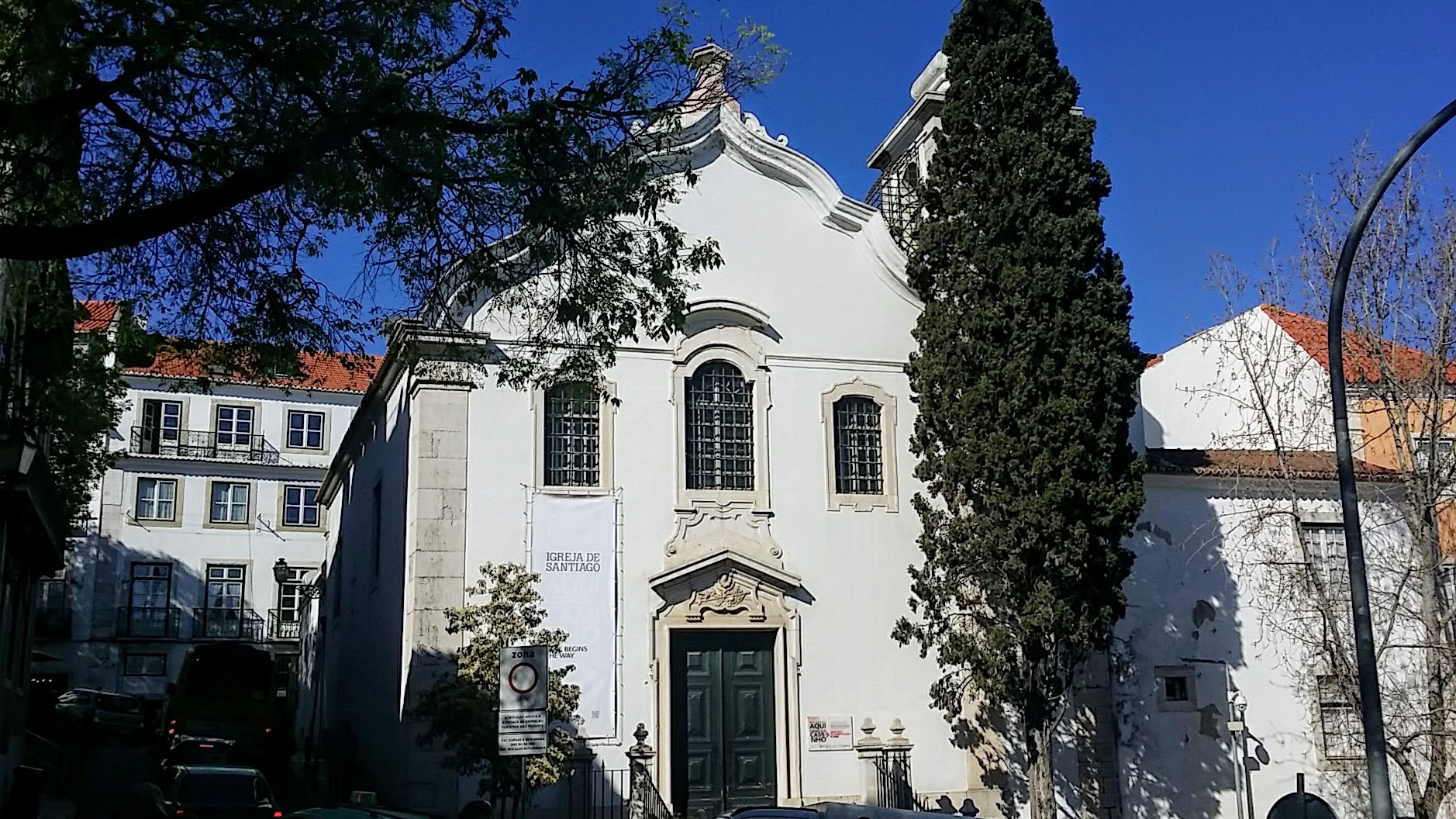










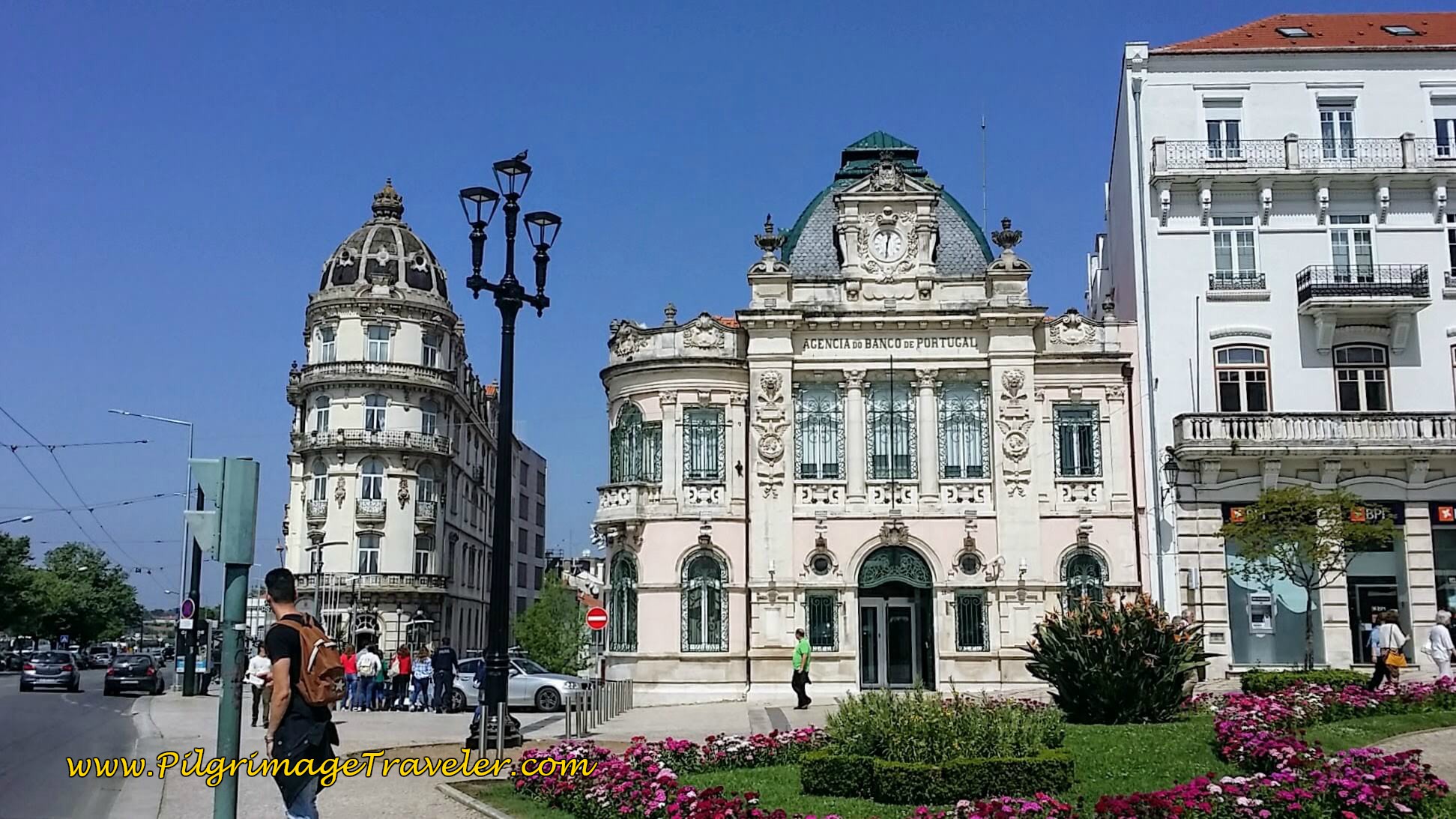






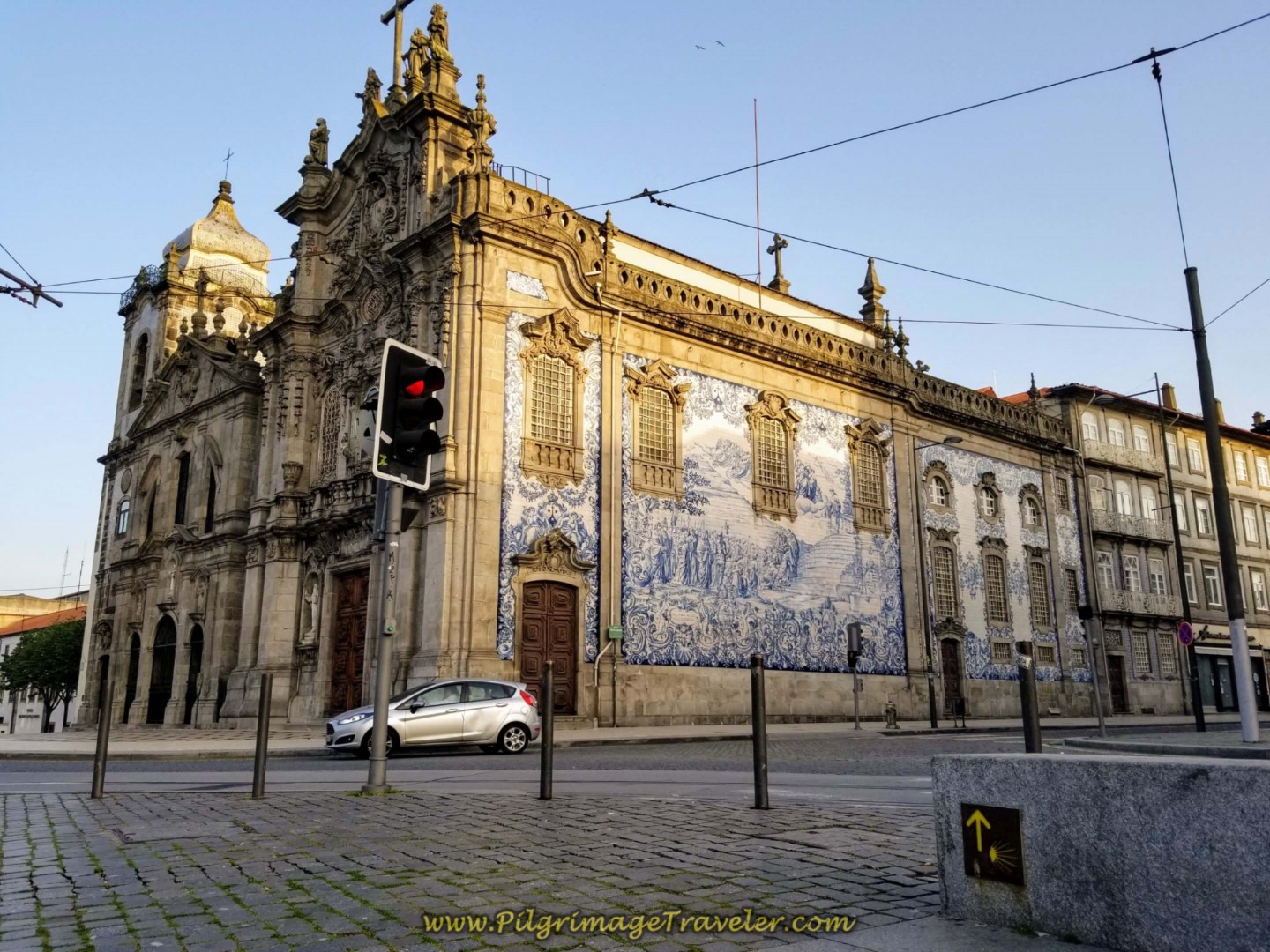








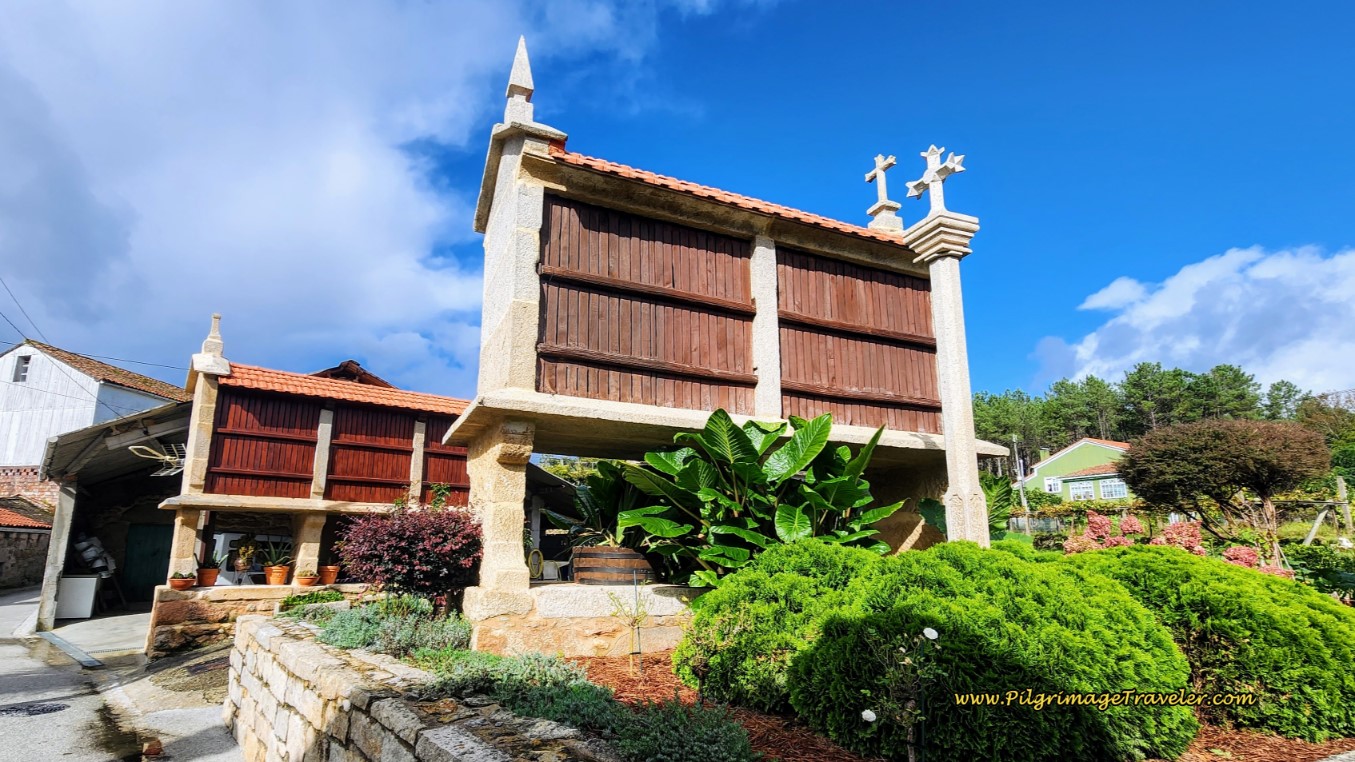































Your Opinion Matters! Comments
Have you had a similar experience, have some advice to give, or have something else you'd like to share? We would love to hear from you! Please leave us a comment in the box below.